The Untold Truth Of Q From Star Trek
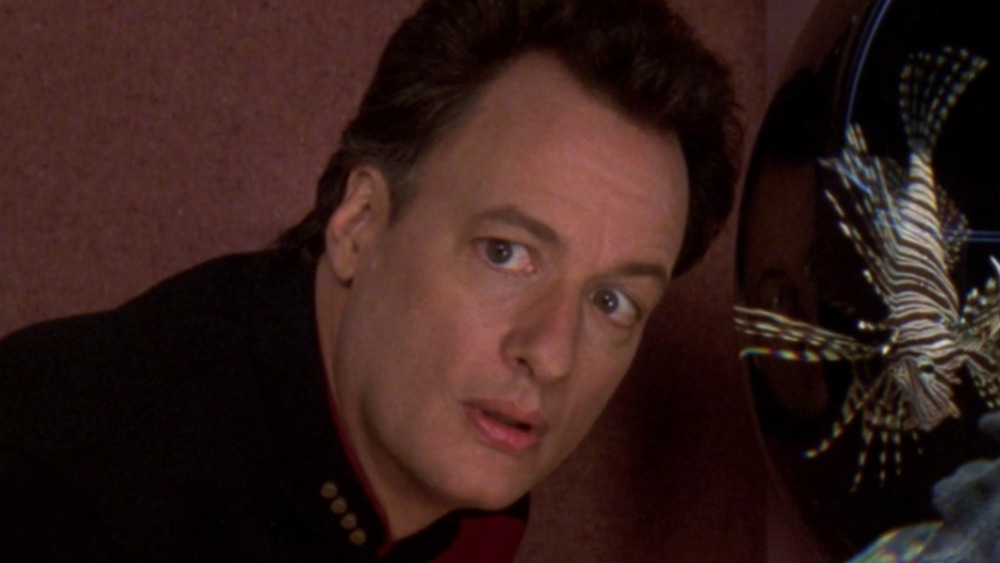
He's an enigmatic, seemingly omnipotent being who manipulates people like they're chess pieces. He's a mischievous trickster who can go anywhere and be anything in our three-dimensional space. He's Q — no other name necessary — and he's proven himself to be both a great ally and antagonist within the Star Trek franchise .
Played by classically trained actor John de Lancie, Q is easily one of Star Trek 's most iconic creations — even though he's only appeared in 13 episodes to date in multiple Star Trek television series. Nevertheless, it sometimes seems Q is everywhere, thanks to all the Star Trek novels, comics, audio books, and video games he's popped up in.
With John de Lancie set to reappear as Q in season 2 of Star Trek: Picard , now's a perfect time to get up close and personal with this omnipotent trickster and find out what makes him tick. Be warned though: de Lancie himself has claimed that Q, much like the infamous English poet Lord Byron, is "mad, bad, and dangerous to know." With that in mind, let's delve into the many secrets of Star Trek' s Q.

Q is named after a Star Trek fan
At first glance, Q's name seems ridiculously simple. It's just one letter — how hard could it have been to come up with? But according to the 4th edition of the Star Trek Encyclopedia, the story behind Q's designation has a curious link with the Star Trek fandom.
Q was named by none other than Star Trek creator Gene Roddenberry, who chose the unusual alias in honor of his friend Janet Quarton. A long-time Star Trek fan , Quarton was the president of the Star Trek Action Group (STAG), an early Star Trek fan club. She also helped publish Star Trek fanzines and organize Star Trek conventions in Britain. Her involvement in the Star Trek fan community caught the attention of Gene Roddenberry who corresponded closely with Quarton over the years.
Later, when Roddenberry helmed Star Trek: The Next Generation, he decided to name the new series' first antagonist after the last initial of his friend — and John de Lancie was dubbed "Q" for the series' pilot episode "Encounter at Farpoint." Given how much future Star Trek fandom would embrace the superbeing, it seems only appropriate that a fan helped name him.
He's not the only Q
John de Lancie may be the face of Q for Star Trek fans, but the truth is he's not the only member of his species — nor do all members of the Q act like him. Over the years, fans have seen many different "Q" entities who all belong to the "Q Continuum," an extra-dimensional plane of existence.
Where de Lancie's Q comes across as a trickster figure, other Qs are more benevolent. In the Star Trek: Voyager season 2 episode "Death Wish," the crew of the U.S.S. Voyager encounters a Q who's been subtly influencing human society for the better — making sure an apple fell on Sir Isaac Newton's head to inspire his theory of gravity and saving Commander William Riker (Jonathan Frakes)'s ancestor during the Civil War. Other Q members prefer to live quietly, including a couple who disguised themselves as humans and had a daughter, Amanda Rogers (Olivia d'Abo) , in the Star Trek: The Next Generation season 6 episode "True Q."
In fact, in "Death Wish," it's revealed that most of Q society is bored with their immortality and power, which helps explain why de Lancie's Q likes hanging out with human beings so much — they're much more fun than his own people.
Q is very similar to a classic Star Trek antagonist
When Gene Roddenberry first came up with the idea to put Q in the pilot episode of Star Trek: The Next Generation, other members of the writing team hated the character and advised him not to use him in the pilot.
Why? According to the Star Trek reference book, The Fifty-Year Mission: The Next 25 Years — From the Next Generation to J.J. Abrams, the team saw Q as a copy of Trelane, a character who appears in the original Star Trek season 1 episode "The Squire of Gothos." In the story, Captain Kirk and his crew encounter a powerful alien named Trelane (William Campbell) who makes the Enterprise crew his playthings. Although Trelane appears all-powerful, we learn he's the child of two other omnipotent beings who make him stop bothering the U.S.S. Enterprise.
While similar to Trelane, both Roddenberry and de Lancie worked to make Q a unique entity. Nevertheless, fans continue to see the parallels and non-canon Star Trek media makes links between the two. In his novel Q-Squared, writer Peter David reveals Trelane is, in fact, another member of the Q Continuum. Then in the Star Trek comic book storyline "The Q Conflict," Q assembles a team of omnipotent beings including Trelane to make multiple Star Trek crews battle in a cosmic-level game.
Q can make other people omnipotent
Q's powers are immense, which he's repeatedly demonstrated throughout his appearances throughout the Star Trek franchise. With a snap of his fingers, Q can teleport himself and anyone else to any place or time. He can rewrite the very fabric of our universe — moving asteroids or even creating pocket realities. And he's nearly omniscient, claiming in the Star Trek: The Next Generation season 3 episode "Deja Q" that he has "an IQ of 2005."
And thanks to his powers, Q can give anyone the abilities of a god — which he does to Commander William Riker in the Star Trek: The Next Generation season 1 episode "Hide and Q." Riker gains the ability to transport his crew mates anywhere he wants without relying on their usual transporter technology. He resurrects Worf (Michael Dorn) from the dead, ages teenager Wesley Crusher (Will Wheaton) to an adult, and even gives blind Geordi LaForge (LeVar Burton) natural vision.
However, every member of the Enterprise rejects Riker's "gifts" (although Worf does get to stay alive), causing Riker to reject his new powers. And it's a good thing too. Q only gave Riker god-like abilities as part of a bet he had with Captain Jean-Luc Picard (Patrick Stewart). By choosing not to be a Q-level entity, Q is forced to leave the Enterprise alone — although he does find enough loopholes to make multiple return visits.
Q isn't all-powerful
While Q might appear to be an all-knowing and all-powerful god to some, the truth is he doesn't have limitless powers. Other members of the Q Continuum can overpower Q or even strip him of his powers, as they did in the episode "Deja Q" by turning him into an ordinary human being with back problems.
In the Star Trek: The Next Generation season 4 episode "Qpid," Q transports the Enterprise crew to a pocket reality where Picard becomes Robin Hood, his crew becomes his Merry Men, and Q himself adopts the guise of the Sheriff of Nottingham. As he explains the rules of his new game, Q reveals that he's given this reality a life of its own and not even he can predict what will happen. This shows that Q is not omnipotent or omniscient, as a truly all-powerful being could not create something capable of overpowering or outsmarting him.
Indeed, this quasi-omnipotence may be the one saving grace for the Q, as involving themselves in games of chance gives them the thrill of not knowing what will happen next.
Star Trek's Q once became super-omnipotent
Q may have been at the mercy of the Q Continuum in many of his early appearances, but a non-canonical comic book storyline shows that he once became super-omnipotent — thanks to J.J. Abrams Star Trek reboot .
In the IDW Star Trek story "The Q Gambit," Q journeys to the Kelvin timeline of the Abrams' films where the younger alternate versions of Captain Kirk and Spock are having their own adventures. Q transports the crew forward into the future where they meet alternate versions of Benjamin Sisko and the crew from Star Trek: Deep Space Nine .
Although this seems to be another one of Q's games, the trickster later reveals the Q-Continuum is in a war against another extra-dimensional race, the malevolent Deep Space Nine villains, the Pah-Wraiths, whose power allows them to fight the Q. To stop them, Spock engineers a situation where Q merges with a member of the Pah-Wraiths' ancient enemy The Prophets. Q evolves into a supremely powerful being who eliminates the Pah-Wraiths with a wave of his hand, and then pops back into the Prime Star Trek universe to show off his super-godly powers to Jean-Luc Picard.
Let's be real: Q is in love with Jean-Luc Picard
Jean-Luc Picard may treat Q with annoyance, but Q has a unique affection for Picard. In "Deja Q," Q admits, "in all the universe, you're the closest thing I have to a friend, Jean-Luc." Data (Brent Spiner) also observes in the Star Trek: The Next Generation series finale "All Good Things..." that, "Q's interest in you has always been very similar to that of a master and his beloved pet" before hastily adding, "That was only an analogy, Captain."
However, in the season 6 episode "Tapestry," Q indicates his interest in Picard goes beyond mere fondness when he shows up in Picard's bed and wakes him with the words, "Morning, darling." The same episode has Q transport a dying Picard back to his Starfleet Academy days so the captain can gain a better appreciation for the mistakes of his past. This indicates Q views himself as Picard's guardian angel, albeit an impish one, who has a special love for the one he calls "Mon Capitane."
Screenwriter Ron Moore agrees, noting in Star Trek: The Official Starships Collection #90 that, "Q was in love with Picard, for some reason. That was the underpinning of the relationship... The weird love affair that he had going with Jean-Luc made that whole thing work."
Q is a lousy boyfriend and father
Sadly, when it comes to showing affection, Q's ego inevitably gets in the way of his relationships. In the Star Trek: Voyager season 3 episode "The Q and the Grey," Q's girlfriend "Lady Q" (Suzie Plankson) shows up when Q flirts with Captain Kathryn Janeway (Kate Mulgrew). The two have been a couple for four billion years, but Q emphasizes, " I never said it was exclusive " while bragging that he uses his omnipotence to seduce females across the galaxy.
In the episode, Q and his girlfriend are on opposite sides of a Q civil war, causing their relationship problems to threaten the universe with multiple supernova explosions. Q's idea to end the war is to impregnate Janeway and adding human DNA to the Continuum — an idea the Voyager captain roundly rejects. However, Janeway convinces Q to have a child with Lady Q instead, leading to a truce between the two factions.
Unfortunately, Q turns out to be a lousy father and in the Star Trek: Voyager season 7 episode "Q2," his son "Q Junior" (played by de Lancie's real-life son Keegan de Lancie) becomes a juvenile delinquent who starts wars, tampers with gene pools, and punches holes in space time. To get him to reform, Q strips Junior of his powers and dumps him on Voyager, where Junior makes friends and learns to value life. While this is good for the universe, it shows Q still tries to get other people to solve his problems instead of dealing with them himself.
Q really hates the Enterprise's bartender (and she hates him back)
Q's antics have earned him plenty of enemies across the universe, but oddly enough, one of the people who hates him the most is the Enterprise's beloved bartender Guinan (Whoopi Goldberg) . One of Star Trek: The Next Generation 's most serene and level-headed characters, Guinan reveals in "Q Who" that she has had "some dealings" with Q during the 22nd century that left them enemies. Q himself dislikes Guinan, calling her an "imp" and warning that wherever Guinan went, trouble follows.
Guinan gets a chance to strike back at Q in the season 3 episode "Deja Q" when the Q Continuum strips Q of his powers and renders him a mere human. Taking the opportunity to taunt the powerless Q, Guinan takes a fork and stabs him in the hand. Shortly after, one of Q's other enemies, the Calamarain, attacks him. As he screams in pain, Guinan only smirks and comments, "How the mighty have fallen."
Q gave Starfleet a head start against the Borg
Q once put the U.S.S. Enterprise through a hellish experience that, strangely enough, turned out to be a favor in disguise. After Picard arrogantly tells him that his crew is prepared to deal with any dangers the universe might hold for them, Q transports the Enterprise into an uncharted sector of space where they encounter the Borg, a powerful cybernetic race intent on assimilating all useful life and technology into its collective consciousness.
Unable to adequately counter this advanced form of life, Picard loses eighteen members of his crew to the Borg and admits his crew's shortcomings to Q, who transports the Enterprise back to the Alpha Quadrant. While Q's actions appear cruel and vindictive, Picard later realizes that the trickster gave Starfleet a "preview" of one of the biggest threats they would soon face — granting the Federation time to prepare an adequate defense. it seems appropriate that the Federation is one of the few galactic societies to have successfully fought back the Borg time and time again — probably due in part to Q giving humanity a glimpse at the threat the Borg would eventually pose.
Q has been out-debated by Spock
If there's one Star Trek character who's the antithesis of Q, it's Spock — the cool, logical Vulcan immortalized by actor Leonard Nimoy . While Spock and Q were introduced in two separate series, they get to spend some time together when Nimoy and John de Lancie teamed up to produce the audiobook Spock vs. Q . Recorded in front of a live audience, the performance sees Ambassador Spock attempt to warn humanity of an approaching asteroid, only to be stopped by Q who believes humanity is not worth saving.
The two get into a lively debate over humanity's strengths and flaws, with Spock's clever logic ultimately triumphing over Q's chaotic ego. In the end, the Vulcan manages to convince the trickster to push the asteroid away so it'll hit Earth a several years later, buying humanity enough time to work together and stop it when it finally does arrive.
The audio drama proved popular and was followed by a sequel, Spock vs. Q: The Sequel . Weirdly, in this new story, Spock and Q switch personalities, causing Spock to become goofy and silly while Q gains a more logical perspective. More of a comedy routine than a debate, this audio performance ends with the two realizing there are higher powers in the universe than the Q.
Q appears in five different Star Trek shows
While Star Trek fans may love Q, the producers and writers tend to use him sparingly, arguing that the super being is more effective when he only appears every now and then. Nevertheless, Q has managed to appear in four separate Star Trek television shows — and will appear in a fifth when season 2 of Star Trek: Picard comes out.
Unsurprisingly, most of Q's appearances are in Star Trek: The Next Generation where he manages to annoy or threaten Picard and the Enterprise crew on eight separate occasions, including in the series pilot and the series finale. Q also appears in the Star Trek: Deep Space Nine season 1 episode "Q-Less" where he meets (and boxes with) Commander Benjamin Sisko (Avery Brooks).
Q is reimagined in the three Star Trek: Voyager episodes he appears in, which portray him as a reluctant family man as well as a representative of the Q Continuum rather than a wandering rogue. His most recent appearance is an extremely brief cameo in the animated Star Trek: Lower Decks season 1 episode "Veritas," where he shows up just to poke fun at (who else?) Jean-Luc Picard.
Given all the different ways Q has been portrayed over the years, it's anyone's guess how de Lancie will play the trickster in Star Trek: Picard. Considering that Q's main appeal has always been his unpredictability, here's hoping his next appearance will show us some new truths of the enigmatic Q.

- View history
Q was a highly powerful individual from a race of godlike aliens known as the Q .
- 1.1.1 Trial
- 1.1.3 Guide
- 1.1.4 Being Human
- 1.1.5 Meeting Vash and acting as benefactor
- 1.1.6 Never-ending trial
- 1.2.1 Quinn
- 1.2.3 Junior
- 1.3 The Cerritos
- 1.4 The Road Not Taken
- 1.5 Visiting Jack Crusher
- 2 Q's disguises
- 3 Locations "created" by Q
- 4.1 Appearances
- 4.2 Background information
- 4.3 Apocrypha
- 4.4 External links
History [ ]
Q appeared to the crews of several Starfleet vessels and outposts during the 2360s and 2370s . As a consequence, all command level officers in Starfleet were briefed on his existence thereafter. One such briefing was attended by Benjamin Sisko in 2367 . ( DS9 : " Q-Less ") Q typically appeared as a humanoid male , though he could take on other forms if he wished, and was almost always dressed in the uniform of a Starfleet captain . ( VOY : " Death Wish ")
In every appearance, he demonstrates superior capabilities, but also a mindset that seemed quite unlike what Federation scientists expected for such a powerful being. He had been described, in turn, as "obnoxious," "interfering," and a "pest." However, underneath his acerbic attitude, there seemed to be a hidden agenda to Q's visits that often had the best interests of Humanity at their core.
On Brax , he was known as "The God of Lies ." ( DS9 : " Q-Less ")
In the 22nd century , Q had "some dealings" with the El-Aurian Guinan . These encounters resulted in strong antipathy between them. ( TNG : " Q Who ")
When temporarily rendered Human by the Q Continuum , Q claimed to possess an IQ of "two thousand and five". ( TNG : " Deja Q ")
Q occasionally used verbal contractions in regular speech, but not often, as part of his chaotic god title. ( citation needed • edit )
By 2401 , Q was, for an unknown reason, dying, something that he had not believed to be possible. ( PIC : " Mercy ") Not wanting Picard to die alone as Q was about to, he endeavored to unshackle Picard from his past guilt so that he could move forward with his life simply because Q genuinely cared about Picard and wished to help his friend rather than for a grander design of some kind. To this end, Q intervened to save Picard and his friends from the destruction of the USS Stargazer and created an alternate timeline by altering the history of the Europa Mission in 2024 . After Picard and his friends restored the original timeline, Q revealed his true intentions and used the last of his power to send them home and to resurrect Elnor . Q's death saddened Picard who had come to see the being as a true friend and who ensured that Q was not alone when he finally met his end. ( PIC : " Farewell ")
In 2402 , despite his apparent death, Q appeared to Picard's son Jack Crusher , simply chiding him for thinking too linearly when asked about his death. Q told Jack that while the trial of humanity had ended for Picard, it had only just begun for Jack. Q's response to Jack's question about his death suggests that either Q never died or Jack was not meeting him in linear order to Picard's last encounter with Q, meaning that this Q may have been a version from before his supposed death. ( PIC : " The Last Generation ")
Picard and the Enterprise -D [ ]
Q was first encountered by the Federation when he appeared aboard the USS Enterprise -D in early 2364 . He warned the crew of the Enterprise that Humanity should return to their home star system or be destroyed.
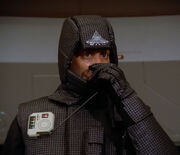
Q appearing as a soldier of the Third World War
When he encountered resistance, Q placed Humanity on trial, with Jean-Luc Picard and his command crew as representatives. Q accused Humanity of being a "dangerous, savage child-race". Picard managed to strike a deal with Q, however, and submitted to a test of conduct to prove that Humanity had evolved beyond its previously savage state.
The Enterprise 's mission to Farpoint Station served as this test. The Starfleet crew sufficiently proved their evolved state of being by discovering and assisting a space vessel lifeform that had been coerced by the Bandi to take the form of a starbase . Q disappeared, but promised the crew they had not seen the last of him. ( TNG : " Encounter at Farpoint ")
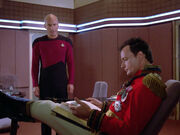
Q explaining to Picard that how Humans respond to a game tells more about them than a direct confrontation
The next time Q appeared on the Enterprise later that year, he created a bizarre and deadly "game" for the ship's crew, in order to demonstrate that he had given Commander William T. Riker Q-like abilities. His motives for this were that Humans had a desire to grow and explore, which the Q did not have or understand. Q wanted Riker to join the Continuum so they could understand and possess this desire because if they did not, Humanity could one day surpass the Q.
Q and Picard settled on a bet that, if Riker rejected his offer, the Q would leave Humanity alone forever. Ultimately, Riker rejected these new powers, and Q was forced back into the Continuum. ( TNG : " Hide And Q ")
Because of those actions, Q was asked to leave the Q Continuum. ( TNG : " Q Who ")
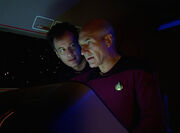
" Do we stay out here years? Decades? "
Q's third appearance on the Enterprise was in 2365 . He presented himself as homeless and expressed an interest in joining Picard's crew, his reason being that Humanity would eventually push into uncharted territory and would need a guide as they were ill-prepared to face what they would find. He even offered to renounce his powers to prove that his offer was genuine. However, when Picard vehemently declined (inspired by thinking that Humanity could handle any threat), Q hurled the Enterprise into the path of a Borg cube . Ultimately, Picard had to beg for Q's help in escaping from the pursuit of the Borg ship. ( TNG : " Q Who ")
In that encounter, Q alluded to a past association with Enterprise bartender Guinan. She declined to elaborate on the nature of their relationship, other than to express an extreme dislike for Q. Based on Q's reactions, the sentiment seemed mutual. ( TNG : " Q Who ")
Being Human [ ]
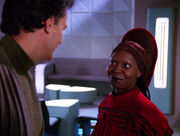
Powerless, Q meets Guinan in Ten Forward
In 2366 , Q was stripped of his power and immortality and transformed into a Human by the Q Continuum, as punishment for his irresponsibility. He sought refuge on the Enterprise , and requested asylum and protection from the beings in the universe whom he had tormented. Though Captain Picard and the rest of the crew were unconvinced of the sincerity of Q's plea and indeed suspected the entire situation was merely an elaborate prank, Picard agreed to provide Q temporary asylum. During a visit to Ten Forward (almost humorously), Guinan took advantage of the situation and stabbed Q in the hand with a fork. Though not a scientist, Q provided theoretical guidance for Geordi La Forge 's analysis of Bre'el IV 's moon , which was in danger of colliding with its planet of orbit . During that time, Data was assigned to watch Q and Q gained an unusual perspective on Humanity and its condition from observing Data, in turn. However, after a Calamarain attack nearly destroyed Data (who risked his life to protect Q), Q became ashamed of his newly-discovered lack of empathy for other beings, and resolved to leave on a shuttle, allow the Calamarain to kill him, and prevent further risk to the Enterprise crew. Another Q intervened at that point, acknowledged Q's selfless act and restored his powers as a reward. In gratitude, Q corrected the orbit of the moon and also gave a special gift to Data, his "professor of the Humanities", a brief moment of genuine laughter. ( TNG : " Deja Q ")
Meeting Vash and acting as benefactor [ ]
In 2367 , the Enterprise crew encountered a woman claiming to be the mythical Ardra of Ventax II . Her demonstrations of omnipotent power resembled those of Q, to the extent that the Enterprise crew speculated that she might be of the Q Continuum or perhaps Q himself. Picard pointed out that the woman's obsession with the Contract of Ardra was atypical of Q and her powers were later proved to be the product of sophisticated technology rather than any innate ability. ( TNG : " Devil's Due ")
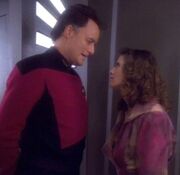
Q and Vash visiting Deep Space 9 in 2369
Later, in 2367 , Q returned to the Enterprise to "properly" thank Captain Picard for his role in helping him regain his standing in the Continuum. At the time, Picard was meeting a past lover named Vash (whom he had met on Risa ) the year before. ( TNG : " Captain's Holiday ") Q resolved to teach Picard a lesson about love, and cast Picard, Vash, and the Enterprise command crew into an elaborate scenario styled by the ancient legend of Robin Hood . Q himself assumed the role of the High Sheriff of Nottingham . Ultimately, Picard learned and everyone was returned to the Enterprise . However, intrigued by Vash, Q offered to take her on a journey of exploration to various archaeological ruins of the galaxy and she accepted. To pay his debt to Picard, he promised no harm would come to Vash. ( TNG : " Qpid ")
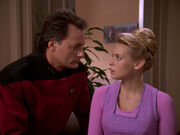
Q encouraging Amanda Rogers to use her Q powers
In 2369 , he once again appeared aboard the Enterprise -D, this time to instruct Amanda Rogers , a seemingly Human female who developed Q powers during an internship with Doctor Beverly Crusher . Shortly after Rogers' birth, the Continuum used a tornado to execute Rogers' parents, two Q who had assumed life as Humans on Earth, for being unable to resist using their powers while in Human guise. Although Q's petulant and acerbic attitude did little to ingratiate himself to Amanda, he eventually convinced her to go with him to the Continuum to learn to use her new-found abilities. ( TNG : " True Q ")
A few months later, Q followed Vash back to the Alpha Quadrant , after the discovery of the Bajoran wormhole created a new avenue of travel between there and the Gamma Quadrant . Having had so much fun with Vash, Q wanted to continue exploring the galaxy , but Vash wanted nothing to do with him. While the two were at Deep Space 9 , mysterious power drains were thought to be Q's doing, but they were, in fact, due to an embryonic lifeform that Vash had unknowingly returned from the Gamma Quadrant. Q had a brief confrontation with Commander Benjamin Sisko during his visit and disrupted an auction that Quark and Vash staged in Quark's . Though he was intrigued by Sisko hitting him as Picard never did, Q eventually became bored because "Sisko was so different than Picard," being so much easier to provoke. One might speculate that Q's actions were intended to ensure Vash's safety in regards to the promise that he had made to Picard two years earlier. In the end, Q and Vash went their separate ways, though both eventually admitted to retaining a certain fondness for each other. ( DS9 : " Q-Less ")
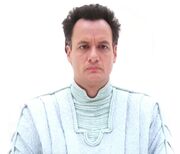
Q appearing to Picard as "God" in the afterlife
Later that same year, Q appeared to Picard when the latter was critically injured in a Lenarian ambush. Appearing as "God", Q told Picard he died because of his artificial heart and offered him the chance to return to the incident in his youth, which allowed him to relive the events leading up to his near-fatal injury and change history. Though Picard was successful in changing history, he eventually realized the event – and his previous nature as an arrogant, brash young man – was a part of his identity, and had helped mold him into the successful Starfleet officer he became. Even though he was uncertain as to whether the experience had been real or simply a vision, Picard was grateful for Q's revelation. ( TNG : " Tapestry ")
Never-ending trial [ ]
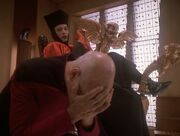
Q congratulating Picard for his method of collapsing the anomaly
In 2370 , Q returned to the Enterprise to continue the trial against Humanity. Claiming the seven-year-old trial never actually ended, Q proclaimed Humanity guilty of "being inferior" and informed Picard that his race was to be destroyed. He sent him traveling through time to his own past and present, as well as to a potential future. In all three time periods, Picard was presented with a temporal paradox in the form of an eruption of anti-time in the Devron system . In that paradox, Picard himself was responsible for the creation of the anomaly, which propagated backward in normal time, anti-time having the opposite properties of normal time, thus destroying Humanity in the past.
In addition to sending Picard jumping through time, Q provided him with hints to understanding the nature of the paradox. Ultimately, Picard determined the solution and devised a way to close the anti-time anomaly in all three time periods. Following the success, Q revealed that the entire experience had been a test devised by the Continuum and had been aimed at determining whether Humanity was capable of expanding its horizons to understand some of the advanced concepts of the universe, including the potential of Humanity's own evolution – but helping Picard had been his idea. Q promised to continue watching Humanity and proclaimed that " the trial never ends. " ( TNG : " All Good Things... ")
Janeway and Voyager [ ]
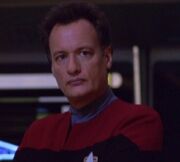
Q debuting on Voyager
In 2372 , Q was sent by the Continuum to board the USS Voyager , whose crew had unintentionally released a renegade Q from confinement in a rogue comet . When the other Q (later known as "Quinn") asked for asylum on Voyager in order to fulfill his wish to commit suicide , an act considered illegal in the Continuum, Q was permitted to represent the Continuum at a hearing to determine whether the requested asylum would be granted. Q argued that permitting a Q to commit suicide would cause unspeakable chaos and disorder – a profound irony, considering Q's own history as a prankster and renegade. When confronted with his past deeds, Q commented that [his] record has been expunged.
Ultimately, Quinn's arguments prevailed and he was made into a mortal being. Q himself was touched by Quinn's dedication and beliefs – Quinn had previously been an admirer of Q's because of Q's propensity to stir controversy and spread chaos – and actually provided Quinn with the means with which to commit suicide. Q resolved to return to some of his old habits and to encourage the Continuum to allow more chaos into their own order. ( VOY : " Death Wish ")
Following the death of Quinn, a massive Q Civil War broke out as the forces of the status quo resisted the calls for change in the Continuum, by a faction led by Q himself. Seeking to end the conflict, Q devised a plan to mate with Kathryn Janeway , the captain of Voyager , in order to create a new Q / Human hybrid – a new breed of Q that would help bring an end to the civil war. However, Janeway flatly refused.
Q kidnapped Janeway and took her to the Continuum, where he again tried to persuade her by explaining the nature of the conflict. However, Janeway again declined, though she openly sympathized with Q for his inability to understand love and tried to negotiate a truce between the two sides. However, those negotiations failed because the status quo faction refused to accept any terms other than surrender. They tried to execute both Q and Janeway, but they were stopped by personnel from Voyager , with the assistance of Q female , an old flame of Q's. Q and the female Q were able to equip Janeway and the rest of Voyager 's crew with Q weapons , which they were able to use to battle the opposing status quo faction.
Q proposed mating with his old girlfriend instead of with Janeway and she agreed. The new child, nicknamed " Q junior ," became the first child born in the Continuum for millennia and his presence brought an end to the civil war. ( VOY : " The Q and the Grey ")
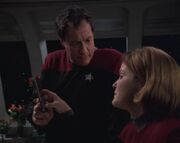
Q giving Janeway a PADD
Regardless, Q's child did not prove to become the perfect "savior" child he was meant to be; he grew into a spoiled brat and caused chaos and disorder. Q tried to briefly leave his son with "Aunt Kathy" aboard Voyager and hoped that Janeway's "vaunted Starfleet ideals" would rub off on him. Q himself began to learn more about the role of being a parent, revealing that much of Junior's actions were not punished properly by Q. However, after spending years with the child, Junior only began to behave worse. As a result, the Continuum stripped his son of his powers, left him aboard Voyager (again under the care of Janeway), and told him to change his ways within a week or he would be sentenced to spend eternity as an Oprelian amoeba .
Though Q was initially unimpressed by his son's progress, he devised a test of "Q-ness" to determine whether his son had improved his attitude. He masqueraded as a Chokuzan captain and threatened Junior and his friend Icheb after they took the Delta Flyer from Voyager . Junior passed with flying colors and offered to sacrifice himself to face the consequence of his actions, which had endangered Icheb.
However, the Continuum was not impressed by Junior's progress and sentenced him to remain a Human. Outraged, Q proclaimed he would leave the Continuum if his son was not allowed to rejoin – the pair was a "package deal". "Begging for [Q's] return" as a deterrent to instability, Q earlier stated that he "holds them all together", the Continuum acquiesced, on one condition – that Q retain eternal custody of the boy. Grateful for her assistance, Q provided Janeway with a map to a shortcut that would shave three years off Voyager 's journey home. Janeway asked Q why he did not send them all the way back to Earth and his response was that it would be setting a bad example for his son if he did all the work for them. ( VOY : " Q2 ")
The Cerritos [ ]
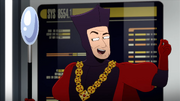
Q aboard the Cerritos
Q's reputation preceded him aboard the USS Cerritos , when in 2380 , he was referenced by Ensign Brad Boimler in a simile explaining the existence of his girlfriend , Lieutenant Barbara Brinson , whom he described as being "as real as a hopped-up Q on Captain Picard Day ." ( LD : " Cupid's Errant Arrow ")
That same year, he made multiple appearances aboard Cerritos . At one point, while wearing a variation of his judge's garb, he abducted four members of the bridge crew to participate in one of his challenges. He dressed the crew up as chess pieces , and put them on a large chessboard, but had anthropomorphic playing cards holding hockey sticks as the opposing pieces, football goal posts at either end of the game board , and a singing , dancing soccer ball .
After the Cerritos left K'Tuevon Prime , Q appeared before Ensigns Beckett Mariner , Brad Boimler, Sam Rutherford , and D'Vana Tendi to challenge them. Mariner told him they were not in the mood and walked away, even as Q followed them and urged them – in vain – to continue, and lamented that he found Picard to be boring. ( LD : " Veritas ")
The Road Not Taken [ ]
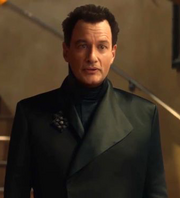
Q appears before Picard following the destruction of the Stargazer
At some point prior to 2401 , Q began to experience a change he believed was impossible: despite everything he believed about the Q as a species, Q was not truly immortal, and he realised that he was going to die. Symptoms of this phenomenon were that Q had begun to lose his powers. Q thought of it as being on "the threshold of the unknowable" and believed that he was about to be "enveloped in the warm glow of meaning" now that his life had a definite end in sight. ( PIC : " Mercy ")
In 2401, three decades after their last encounter, Q visited Picard at his home on Earth . After having ordered USS Stargazer to self-destruct in order to stop the Borg from seizing control of the Starfleet armada, Q had intervened to stop Picard's death. ( PIC : " Penance ") Picard had awoken in his home to find that not only was he alive, but several things had changed. Picard turned to face Q, and Q remarked that Picard was older than he imagined. Snapping his fingers, Q updated his appearance to more closely match the aged Picard and reminded Picard about the words that he imparted to him when they last parted ways, " the trial never ends. " Q reminded Picard about how he had talked about second chances and told him that he was now at the " very end of the road not taken. " ( PIC : " The Star Gazer ")
Following Picard's question as to where they were, Q explained to Picard that he had brought him "home". After Picard inquired about the whereabouts of the Stargazer crew, Q admitted that there was no Stargazer . Picard demanded to know what Q had done, to which Q responded that he had merely shown Picard a world of his own making and stated that it was "Human" of Picard to instead blame him. Picard angrily asked if Q had had enough of playing games with other peoples' lives and exclaimed that he was no longer Q's pawn, to which Q answered that Picard was much more than a pawn – he was instead the " very board upon which this game is played ". When Picard told him that he was too old for Q's "bullshit", Q angrily affirmed that Picard was old, and lamented that time was unfair and had presented Picard with " so many wrinkles... so many disappointments. " Picard demanded that Q get to the point, to " cut to the chase ". Q rambled to Picard about the chase bleeding out and how he was a suture on the wound. Noticing Q's odd behavior, Picard asked Q if he was unwell. Q responded by transporting them both to the vineyard.
At the vineyard, Picard asked again what had happened to the crew of the Stargazer , and Q acknowledged that he had intervened because he had wanted to see him. Picard demanded that Q tell him what he wanted, and Q told him that while he could tell him, Picard was too clever to listen. Picard told Q that he had enough of Q's patronizing, and Q struck Picard, angrily telling Picard that he had had enough of Picard's stubbornness, obstinance, and " insistence on changing in all ways but the one that matters ". Q declared the situation was not a lesson but instead a penance. Q explained that in Picard's original history, Humanity had found a way to spare the planet they were "murdering", but in this timeline, Humanity " keeps the corpse on life support ". Q once again transported Picard back inside the château, where he revealed several alien slaves working for Picard. Despite Picard's insistence that he would never do this, Q stated that " such moral convictions are the luxury of the victors ".
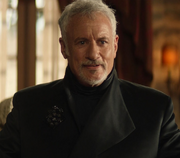
Q offers Picard a choice between remaining as he is, or a chance at "atonement"
Q brought Picard inside the trophy room , explaining the life that Picard had led in this new timeline. Q talked through several of Picard's trophies – including the skulls of Dukat , Martok , and Sarek , all of whom this timeline's Picard had executed in brutal fashion. Q called Picard " the most bloodthirsty, merciless, ruthless Human to ever set out to conquer the galaxy " and asked if Picard wished to see what else had been lost thanks to Picard's fear. He offered Picard a choice: he could remain as he was in this world, trapped inside " the body of a madman, in the world of a madman ", and try to " wash the blood " from his hands for the brutal murders committed by his counterpart – though Q deemed that to be "unwashable". Q offered an alternative: Picard could show atonement, possibly forgiveness. When Picard asked what he would be forgiving, Q answered cryptically that Picard already knew. Q stated that he would not let Picard take this on alone. Picard refused Q's choice and Q left him alone.
Picard would later inform Seven of Nine and Raffaela Musiker of his encounter with Q, and explained that Q would in the past put him to the test using "games" such as the situation they found themselves in. He told them that he felt that there was something wrong with Q, as he was acting stranger than usual.
A Borg Queen held captive in Agnes Jurati 's laboratory was able to perceive the fracture in the timeline and calculated that Q had implemented a single change in the year 2024 to create the current timeline. ( PIC : " Penance ") Q briefly appeared again to Picard aboard CSS La Sirena to repeat his words about this being the only life Picard understood. ( PIC : " Assimilation ")
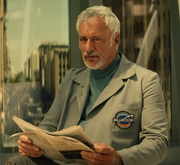
Q observing Renée Picard, about to attempt to interfere with her mission
Q later observed Renée Picard reading a book before she undertook the Europa Mission . Q attempted to amplify Renée's fear about the upcoming mission, but his powers failed. ( PIC : " Watcher ")
He next attempted to get assistance from Adam Soong , whom he promised to give a cure for his daughter 's genetic disorder . ( PIC : " Fly Me to the Moon ")
During a gala celebrating the Europa Mission, Q, posing as Renée's therapist, encouraged her not to go on the mission and nearly succeeded. However, Picard successfully foiled Q's plan. In response, a desperate Soong tried to run down Renée, only to have Picard take the hit himself in order to save her life. ( PIC : " Two of One ")
Jean-Luc survived and met with Guinan, who performed an El-Aurian ritual in an effort to summon Q. The ritual appeared to fail, and shortly after, Guinan and Jean-Luc were arrested by a team of FBI agents led by Martin Wells . ( PIC : " Monsters ") Q had heard the summons, however, and visited Guinan in prison, where she realized that Q was dying. Q imparted to her that he was trying to find meaning in his remaining time, and that he was using Jean-Luc as a means to that end. He also demonstrated his loss of power by attempting unsuccessfully to vaporize Guinan. Q left with a parting statement that Humans were " all trapped in the past ", which gave Guinan the clue she needed in order for Jean-Luc to pry into Agent Wells' past in order to secure their release. ( PIC : " Mercy ")
Q later hacked himself into a virtual reality program operated by Kore Soong, to reveal to her the truth and offer himself as an ally, in spite of Adam Soong not keeping his end of their bargain. Kore removed the VR headset to end the conversation, but Q had left the permanent cure – labeled "freedom" – in the airlock for her. ( PIC : " Mercy ")
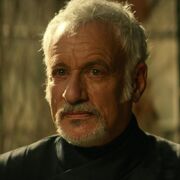
Q before his "death"
After the success of the Europa Mission and the restoration of the original timeline, Picard encountered Q in his home after leaving the skeleton key for his younger self to find in the future. Q noted that although Picard had the chance to potentially save his mother and change his own future, he instead accepted himself as he was and absolved himself. Because Picard had chosen himself, he may now be worthy for someone else to choose and he may even give himself the chance to be loved. Q reminded Picard that he'd told Picard that this was about forgiveness: Picard's own forgiveness of himself. Q stated that Picard had fixed all of the deaths that Q had caused by altering the timeline aside from Tallinn and Elnor . However, Tallinn was always destined to die in every timeline, but thanks to Picard's intervention, Tallinn had met Renée in this one. Picard asked why Q had taken such an interest in him for over thirty years and Q explained that he was dying alone and he didn't want that for Picard. Q had elaborated: " Even gods have favorites and you've always been one of mine. " As such, he had set it up so that Picard would travel back in time and in a round about way come to terms with his mother's death and absolve himself of his perceived responsibility for the event. " As I leave, I leave you free. " For once, Q was not acting as part of some grander design but simply because he cared about Picard and genuinely wanted to help his friend.
Gathering outside, Q prepared to use the last of his power to send Picard and his friends back to their own time, something that would kill Q in his weakened state. With Rios choosing to stay in 2024, Q told Picard that he had an unexpected surplus of energy that he would use to give Picard one last surprise gift. Stating that Q didn't have to die alone, Picard hugged him and an emotional Q promised to " see you out there " and snapped his fingers, sending Picard, Musiker, and Seven back to 2401 moments before the Stargazer 's destruction, allowing Picard the chance to change his future. Shortly thereafter, the group discovered Q's final gift: Q had resurrected Elnor and returned him to the Excelsior . ( PIC : " Farewell ")
Visiting Jack Crusher [ ]
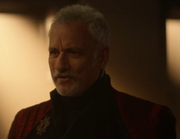
Q in Jack Crusher's quarters aboard the USS Enterprise -G
In 2402 , Q appeared to Jack aboard the USS Enterprise -G . Jack immediately recognized the being, having heard about Q from his father Jean-Luc Picard . Jack was surprised as Q was supposed to be dead, but Q simply stated that he was hoping that "the next generation wouldn't think [time] so linearly", and told him that Jack had much ahead of him. While humanity's trial was over for Picard, Q was here to inform Jack that his trial had only just begun. ( PIC : " The Last Generation ")
Q's disguises [ ]
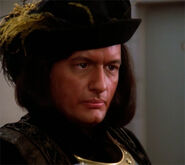
Locations "created" by Q [ ]
- A post-atomic horror courtroom of 2079 ( TNG : " Encounter at Farpoint ", " All Good Things... ")
- The planet of the animal things ( TNG : " Hide And Q ")
- Sherwood Forest ( TNG : " Qpid ")
- The afterlife ( TNG : " Tapestry ")
- The puzzle planetoid ( LD : " Veritas ")
Appendices [ ]
Appearances [ ].
- " Encounter at Farpoint " ( Season 1 )
- " Hide And Q "
- " Q Who " ( Season 2 )
- " Deja Q " ( Season 3 )
- " Qpid " ( Season 4 )
- " True Q " ( Season 6 )
- " Tapestry "
- " All Good Things... " ( Season 7 )
- DS9 : " Q-Less " ( Season 1 )
- " Death Wish " ( Season 2 )
- " The Q and the Grey " ( Season 3 )
- " Q2 " ( Season 7 )
- LD : " Veritas "
- " The Star Gazer " ( Season 2 )
- " Penance "
- " Assimilation "
- " Watcher "
- " Fly Me to the Moon "
- " Two of One " ( flashback ; archive footage)
- " Farewell "
- " The Last Generation " ( Season 3 )
Background information [ ]
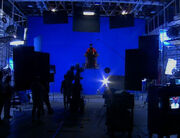
Filming Q's scene in The Next Generation series finale " All Good Things... "
Q was played by John de Lancie ; Q as the Chozukan commander was played by Michael Kagan .
The idea of Q was conceived by Gene Roddenberry as a way to help fill out the events of "Encounter at Farpoint" from a one-hour to two-hour running time. ( Star Trek: The Magazine Volume 2, Issue 12 , p. 28) The name "Q" was chosen by Roddenberry in honor of an English Star Trek fan named Janet Quarton. She was the first president of the UK Star Trek fan club, and Roddenberry and many others spent time at her home, in the Scottish highlands. ( Star Trek Encyclopedia (4th ed., vol. 2, p. 191); [1] )
Immediately after Roddenberry invented the character of Q, the other members of the TNG preproduction staff realized it was very reminiscent of the character Trelane from the Star Trek: The Original Series episode " The Squire of Gothos ". " We're all looking at each other, saying, 'It's Trelane [from the original series] all over again,' " remembered David Gerrold . " We all hated it and very gently suggested to Gene that it wasn't very good. Of course, this fell on deaf ears. He said, 'Trust me, the way I'll do it, the fans will love it.' " ( The Fifty-Year Mission: The Next 25 Years , p. 67)
In an interview, de Lancie likewise drew parallels between Q and Trelane, feeling Gene Roddenberry had explored his storehouse of effective creations in writing The Next Generation and had found one that would turn out to be highly successful again in The Next Generation . [2] In another interview, de Lancie stated that, upon thinking of ways to describe Q's character, he had remembered a famous quote made about Lord Byron : That he was "mad, bad, and dangerous to know." ( Star Trek 25th Anniversary Special )
Minimal makeup was used for the character of Q. " We always defined Q with a little eye makeup and a little lip color, just to make him stand out, " recalled Makeup Supervisor Michael Westmore . ( Star Trek: The Magazine Volume 2, Issue 12 , p. 26)
Production designer Herman Zimmerman was influential in the depiction of Q as a judge presiding over a courtroom . In the script of "Encounter at Farpoint," Q seemed to be floating in that area, though none of the production crew could figure out precisely how to show Q floating without resorting to visual effects for every one of those shots. Ultimately, Zimmerman suggested putting de Lancie on a camera crane and bringing him into the courtroom out of a black hole, which was exactly how Q's arrival in that scene was shot. ( Star Trek: The Magazine Volume 2, Issue 12 , p. 30)
The depiction of Q in "Encounter at Farpoint" turned out to be extremely popular. Yar actress Denise Crosby commented, " The character of Q, and the way John de Lancie was playing it, was really interesting. " Rick Berman noted, " I think [Q] was certainly the most memorable element of that opening episode. " "Encounter at Farpoint" Director Corey Allen remarked, " Q was so clearly a wonderful idea of Gene's, about the questions we all ask ourselves; he was the interrogator that each of us carries on our shoulder. " Herman Zimmerman observed that his idea of having Q arrive in the courtroom on a camera crane "worked very well." ( Star Trek: The Magazine Volume 2, Issue 12 , pp. 19, 28, & 30)
Though a first draft script of TNG Season 1 episode " Hide And Q " that Maurice Hurley penned was substantially rewritten by Gene Roddenberry, the character of Q still intrigued Hurley thereafter. He thought of Q as an unreliable god and subsequently intended for him to feature in a story arc through the second season . Due to a writers' strike though, he was only returned in the Season 2 episode " Q Who " before Hurley left the series. ( Star Trek: The Magazine Volume 2, Issue 12 , pp. 52 & 53)
Rob Bowman , who got an opportunity to direct de Lancie as Q in "Q Who," enjoyed the experience, finding that de Lancie was easy to direct in the role. " He really had a grasp of the peculiarities of that character, " Bowman remarked. ( Star Trek: The Magazine Volume 2, Issue 12 , p. 95)
Though Q was a recurring character over a relatively long time, he was used sparingly by the Star Trek producers in case fans got tired of him. Gowron actor Robert O'Reilly once likened these circumstances to his own situation, regarding his portrayal of Gowron. ( The Official Star Trek: Deep Space Nine Magazine issue 16 , p. 22) Writing staffer Ronald D. Moore commented, " Q was a fascinating character, but I thought that he should be carefully rationed through the series. I thought if you played him about once a season, that was the most you wanted to use him. " ( Star Trek: The Official Starships Collection , issue 90, p. 17)
Devising Q stories challenged the writing staff of Star Trek: The Next Generation due to the character's omnipotence. Q could not be made completely into an adversary as he could simply wipe all the characters out of existence. The fact he was intended to be all-powerful also raised the question of why he even bothered with Humans and their allies. Both Ronald D. Moore and Jeri Taylor found it difficult to write for the character, though Moore also regarded doing so as "fun" because Q's extreme powers allowed the writers a wide variety of stories they could feature him in. ( Star Trek: Communicator issue 113 , p. 68)
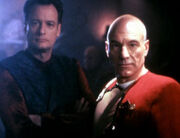
Patrick Stewart and John de Lancie during the filming of " Tapestry "
Following Q's appearance in " Q-Less ", the possibility of him making another visit to DS9 was dismissed by Ira Steven Behr , when he remarked, " I don't foresee Q being back on the show. To me, his relationship with Picard was gold. And I don't think we can top it. " ( AOL chat , 1997 ) Ron Moore agreed, " The secret to Q was the Q and Picard relationship. Q was in love with Picard, for some reason. That was the underpinning of the relationship, which was why, when he came to Deep Space Nine , he wasn't as effective a character. The weird love affair that he had going with Jean-Luc made that whole thing work, and it made ' Tapestry ' work, and ultimately it made ' All Good Things... ' work. " ( Star Trek: The Official Starships Collection , issue 90, p. 17)
Q was originally rumored to make an appearance in Star Trek: Insurrection ; however, Michael Piller ultimately put those rumors to rest. ( AOL chat , 1997 )
In 2002 , Q placed eleventh in TV Zone 's list of the top twenty science fiction television villains, along with several other Star Trek characters; the Borg Queen was second, Dukat was fourth, Weyoun was eighth, and Seska was nineteenth. However, despite his listing, Q is not necessarily a villain, but more of an anti-hero.
Along with Quark, Morn , and Evek , Q is one of only four characters to appear in all of the first three Star Trek series based in the 24th century : Star Trek: The Next Generation , Star Trek: Deep Space Nine , and Star Trek: Voyager . Of these four, Q is the only one who did not appear in " Caretaker ".
Of the thirteen Star Trek episodes featuring Q prior to Star Trek: Picard Season 2 , eight of them use the letter "Q" in the title, often forming a pun.
In " Magic to Make the Sanest Man Go Mad ", having Harcourt Fenton Mudd say " Adieu, mon capitaine " to Captain Gabriel Lorca was intended as an homage to Q. [3]
Q was the first character to ever use the word "trek" in a Star Trek film or episode, which he does in the Star Trek: The Next Generation series finale "All Good Things...". However, Zefram Cochrane is the only character to utter the phrase "star trek," doing so in Star Trek: First Contact .
Apocrypha [ ]
According to Q in the String Theory books, omnipotent beings were actually rather fond of games of choice and chance as it was only under those conditions that beings such as Q could feel the thrill of not being in total control.
Besides the character of Trelane having been an inspiration on the conception of Q in reality, they were both featured in Q-Squared , in which Trelane was actually described as a "child" member of the Q Continuum, even implied to be Q's own illegitimate son.
The reason for Q's original interest in Picard in particular was explained in the novel The Buried Age , which also revealed he chose to call himself "Q" as he felt that his original choice of 'The Inquisitor' would be too complicated for Humans to say regularly, speculating that, if ever asked why he called himself 'Q', he would reply, "Because U will always be behind me."
The audio play " Spock Vs. Q: The Sequel " suggested there was at least one individual "above" Q, naming herself "Petunia", who, in the play, seemed to have taken Q's powers and placed him, together with Spock, on an asteroid.
In the novel Q-in-Law , Q meets Lwaxana Troi who developed romantic feelings toward him when the two came to the Enterprise during a significant wedding in 2366. Q used this to his advantage to perform a cruel experiment on the nature of the Human emotion of love and Q briefly shared his vast power with Lwaxana. When Q was finished with his experiment to prove that love made others blind to faults in their chosen partner and fixated on their own desires, citing as proof how Lwaxana had ignored all the warnings that he would do exactly this, he tried to take the power back without success. Lwaxana used her power to thoroughly humiliate Q as he had humiliated her. It was later revealed that Q2 was responsible for preventing Q from removing Lwaxana's powers as a way to teach Q another lesson about interfering in the lives of mortals.
Q returned in the Star Trek: Ongoing story arc The Q Gambit . Beginning shortly after the events of Star Trek: Countdown , Q visits Picard on board the USS Enterprise -E , informing Picard that Spock was still alive and that the black hole he was pulled into actually sent him into an alternate reality . When Q tries to discuss this timeline, Picard cuts him off, believing that the various timelines should remain separate from one another. Annoyed, Q reveals he had come for Picard's counsel as Spock had set off a chain of events that would doom that timeline. But since the former captain was uninterested, Q took his leave for the other timeline despite Picard's attempt to call him back. Materializing aboard the USS Enterprise on Stardate 2261.34 , Q introduces himself to James T. Kirk by way of masquerading as a security officer (and complimenting the shiny aesthetic of the ship).
To test Kirk's established lack of belief in a " no-win scenario ", Q replicates the Kobayashi Maru scenario in an attempt to teach Kirk that no-win scenarios are a reality. Kirk is undaunted and reveals that no matter what, he does not believe in a no-win scenario. Q takes them both back in time to when Kirk died saving the Enterprise . As the two watch the event, Q asks Kirk if this constitutes Kirk beating the ultimate no-win scenario before revealing he will show Kirk a scenario where failure is a certainty. He then sends the Enterprise and its crew over a hundred years into the future where the Federation no longer exists and the Dominion established an alliance with the Cardassian Union and took over the Alpha Quadrant while existing in a state of cold war against the Klingon Empire .
Q sporadically appears to Kirk throughout the adventure, offering vague advice as well as assuring that he and his crew would not be confined to these dire circumstances forever. After Gul Dukat had merged with a Pah-wraith and intended to ascend to godhood, Q finally appears to Kirk and reveals to him the true magnitude of the stakes: The higher species are at war and the Q Continuum is on the verge of defeat. Galvanized by their victory over the Prophets , the Pah-wraiths have turned on their other neighbors. Not even the Q can stop their onslaught because in spite of all the power they wield in the three-dimensional universe , they are as powerless and clueless as Humans in their own realm. Unable to find a path to victory, Q left to seek the counsel of Picard on what action to take. But when he could not get an answer, Q intended to instead seek the counsel of Kirk for his experience in triumphing over no-win scenarios.
When Q, Kirk, Spock , and Sisko are brought aboard the Enterprise as prisoners, Dukat kills Sisko, who transfers the last Prophet to Spock, and Spock then transfers the Prophet into Q through a mind meld . This causes the two to merge into an even more powerful entity, one readily capable of quelling the Pah-wraith threat. After returning the Enterprise and its crew back to their proper places in time and making it so that only Kirk and Spock remember what happened throughout their ordeal, Q returns to Picard to inform him of his latest adventure. Flatly, Picard said he did not want to know.
In " Connection, Part 1 ", Q is mentioned when Kirk switches minds with his prime timeline counterpart and Kirk initially assumes Q was messing with him again, with a confused Chekov asking who Q is.
John de Lancie shared his own origin story for the Q in an interview following the conclusion of his arc in Star Trek: Picard : " I gave myself a story, which was, Plato’s Cave. “There’s a cave with an entrance [that] the sunlight goes through, there are humans who are chained inside the cave and can only see the wall of the cave. Therefore, everything that goes in front of the cave becomes a projection on the wall. So they are only seeing shadows. Continuing the story, one of them breaks his chains, goes out to the entrance, goes outside, and goes ‘Oh, my God, that is reality – that is truth out there.’ Comes back, [and] tells the humans, ‘These are just shadows, I’m a philosopher now, I’m giving you the truth.’ And of course, they kill him. So I had in my head, what are the Q? The Q are in fact the [people] who are chained, who watch the wall. We are the witnesses, but we are only seeing the shadows. So what have I done? I’m the one who has broken out. And I’m traipsing through the universe trying to actually get the real deal. That was my backstory. " [4]
Q and the Q Continuum appeared in the following non- canon works:
- Spock Vs. Q
- Spock Vs. Q: The Sequel
- Star Trek: Borg - Experience the Collective
- #9: Requiem
- #13: Gods Above
- The Buried Age
- The Eternal Tide
- Encounter at Farpoint
- All Good Things...
- Q's Guide to the Continuum
- " All Good Things... "
- #3: " Q Factor "
- #4: " Q's Day "
- #5: " Q Affects! "
- #33: " The Way of the Warrior "
- #34: " Devil's Brew! "
- #35: " The Dogs of War "
- #79: " Artificiality "
- #80: " The Abandoned "
- Annual #1: " The Gift "
- Star Trek Unlimited #7: " An Infinite Jest "
- " The Q Gambit, Part 1 "
- " The Q Gambit, Part 2 "
- " The Q Gambit, Part 3 "
- " The Q Gambit, Part 4 "
- " The Q Gambit, Part 5 "
- " The Q Gambit, Part 6 "
- Star Trek: Borg
- Star Trek: The Game Show
- Star Trek: ConQuest Online
- Star Trek Online
- Star Trek Timelines
External links [ ]
- Q at StarTrek.com
- Q at Memory Beta , the wiki for licensed Star Trek works
- Q at Wikipedia
- 1 Abdullah bin al-Hussein
Screen Rant
Star trek: 10 facts about q most fans don't know.
Q is a staple of Star Trek lore, and constant headache to Jean-Luc Picard — but there's so much fans don't know.
Q has forever been a thorn in humanity's side, and a constant headache to Jean-Luc Picard. He's thrown the human race into harm's way more than once, but always for the purpose of testing their resolve, and helping them achieve their true potential.
RELATED: Star Trek: 10 Crazy Neelix Fan Theories That Were Actually Confirmed
Far from perfect (or moral), Q is nonetheless a staple of Star Trek lore. Played with brilliant excellence by John de Lancie, he remains a fan favorite to this day. There are so many things, as much as fans love him, that they aren't really aware of about this character...
He Was Named After A Woman
Star Trek creator Gene Roddenberry named Q after a woman...sort of. Roddenberry chose the singular letter "Q" as a tribute to a woman by the name of Janet Quarton, the first President of the U.K. Star Trek fan club.
As history tells it, Roddenberry was good friends with Quarton, who helped push the Star Trek concept to audiences over the pond, and contribute to its success. It may just be a letter, but it's an honorable distinction, nonetheless!
His Debated Entrance
The original depiction of Q's first big reveal was talked about in the script as him being a Judge floating in mid-air inside a courtroom. This description didn't sit well with producers, who struggled to come up with a convincing method of achieving such a shot.
In the end, production designer Herman Zimmerman stuck actor John de Lancie on a camera crane, lit his entrance with a spotlight, and the rest is history. The makeshift approach is readily apparent when one watches "Encounter At Farpoint," a far cry from what could have been done with the CGI of today.
John de Lancie Was A Pro
According to directors who worked with John de Lancie, the actor was professional, easy to work with, and knew his character inside and out. Director Rob Bowman loved working with de Lancie for the iconic season 2 episode "Q Who," which featured the first appearance of the Borg . According to Bowman, the actor "really had a grasp of the peculiarities of that character."
Fun fact: Rob Bowman would also provide the voice of the Borg during the episode - the first to do so.
He Was Challenging To Write
Star Trek: The Next Generation writers had an awful lot of trouble writing the character of Q, but the challenge ended up pushing their creativity and ingenuity to the max. Since the character was essentially a God , he could not be written as a pure antagonist, and since he wasn't entirely benevolent, he had to pose a threat that could be triumphed against.
RELATED: Star Trek: 10 Best Holodeck Characters
In the end, TNG writers broke new ground to write the character into the show by having him ejected out of the Continuum and turned into a human. Future storylines would expand on Q's character and turn him from a renegade troublemaker to a mischievous anti-hero.

The Trelane Connection
According to legend, The Next Generation writers noted obvious similarities between the character of Q, and a previous character known as Trelane from the original series. Roddenberry was confronted over the fact, to which he agreed, but dismissed any warnings that it may look like a character rehash.
Roddenberry was proven right when audiences and critics praised the character of Q in the pilot episode "Encounter At Farpoint." Later, the Trelane connection would be established in the Star Trek novel Q-Squared, where it was revealed that Trelane was indeed a member of the Continuum.
The "Trek" Honor
John de Lancie bears the distinction of being the first Star Trek actor to use the word "Trek" on-screen, during the final episode "All Good Things..." . It was a nice nod to the fandom, and done in such a way as to avoid making it seem too obvious.
The late James Cromwell would get to use the entire term "Star Trek" in the 1996 hit Star Trek: First Contact , but Q beat him to the relative punch, beforehand.
Mad, Bad, Dangerous To Know
John de Lancie has frequently stated in interviews that he drew inspiration for Q from a quote made about Lord Byron by Lady Caroline Lamb, who referred to him as "Mad, bad, and dangerous to know." He used this to fuel the character's penchant for unpredictability, volatility and supreme power.
In history, Lord Byron was a poet and politician born in 1788 who became infamous for marrying his half-sister, which forced him into exile from England. He would die young at the age of 36 after contracting a fever during the Greek War of Independence against the Ottoman Empire.
Spock Changed Him
The audio novel Spock Vs. Q pit the mischievous God against Spock himself, and the two locked intellectual and ideological horns for the first time. The story centered around an asteroid hurtling towards Earth near the end of the 20th century, which would destroy humanity.
Spock travels back in time to try and convince humanity to take the threat seriously, which prompts Q to show up and warn him against direct involvement. Spock retaliates with an intellectual logic barrage, which ends up changing Q's mind about the value of humanity, and what it could become.
He Loved Humanity
Whatever impressions viewers have of Q's confrontational relationship with the human race, it could be argued that he held deep fondness for it. While the character's initial introduction was antagonistic and threatening, later TNG episodes would reveal that Q seemed to have humanity's best interests at heart, and was more than willing to show them a bit of tough love, if it meant their survival.
RELATED: Star Trek: 10 Times Captain Picard Was The Worst
This theory was kicked off during the popular season 2 episode "Q Who," when the cosmic being flings the Enterprise directly into the path of an incoming Borg cube. It would later be revealed that the Borg had prior knowledge of humanity's existence, and were already on an intercept course. By putting the Enterprise in direct confrontation with the cube, he was able to prepare humanity for what was coming, and help avert their destruction by challenging them with a life-or-death scenario - another test for humans to pass.
The Picard Possibility
During an interview with StarTrek.com , de Lancie was asked whether he thinks he'll get a shot at reprising his character in a future episode of Star Trek: Picard. The actor quipped in humorous fashion, "Well, I'm supposed to be immortal, right? Do I look immortal? 32 years is 32 years, so I'm not holding my breath."
While this may be true, it's entirely possible de Lancie is attempting to throw Star Trek fans off. After all, de-aging technology could easily bring Q back into the fold, with de Lancie still in the role. Plus, it would provide excellent closure to Picard's character if he was deemed ready for a final death.
NEXT: Star Trek: The 10 Worst Weapons Ever Used, Ranked
- Newsletters
- Account Activating this button will toggle the display of additional content Account Sign out
The Race to Save Fanfiction History Before It’s Lost Forever
A massive fan project aims to make zines and other physical media available online—before it’s too late..
Archive of Our Own is probably best known as the place to read fans’ carefully crafted Harry Potter prequels or Lord of the Rings stories millions of words long . But the fanfiction website also has a lesser known, though no less important mission: to save older fanfic that’s at risk of disappearing. A new initiative, the Fanzine Scan Hosting Project, aims to make fan stories and art from physical fanzines accessible through the archive, preserving pieces of history previously confined to university libraries, scattered eBay sales, and forgotten corners of attics.
The project is a collaboration with Zinedom, which has been scanning and privately archiving fanzines for many years. Morgan Dawn, the project’s organizer, says that the collaboration actually began with frustration directed at AO3. In 2012, Dawn had scanned a fanzine called Angel in the Dark , a 144-page novel based on crime drama The Professionals . But when paper documents are scanned, they do not come in easily editable formats, and converting them often introduces many errors that require extensive editing to fix. Not having the energy to do so, she linked out to a Google Drive containing the PDF file. But it was removed from AO3 in 2017, because the link itself was not a fan work.
The experience led to discussion among fans about the barriers to preserving fan history, including AO3’s format requirement and the fact that the responsibility primarily fell to older fans, the ones with the physical zines. Dawn launched the Zinedom project to begin to combat that, with a few volunteers beginning to convert, edit, and upload some of the zines where they had permission to do so.
“It went for about a year,” she said. But “logistically, for a small group of 20 to 30 people who weren’t organized, it just didn’t work.” She turned to Open Doors, another segment of AO3’s parent company, the Organization for Transformative Works, which is dedicated to saving “those fannish projects that might otherwise be lost due to lack of time, interest, or resources on the part of the current maintainer.” It took until this year for the collaboration to get off the ground.
[ Read: The Plight of the Former Fanfiction Author ]
Eskici, an Open Doors chairperson who prefers to go by her online handle while discussing her volunteering, says there were several factors in the delay. The collaboration was originally piloted and approved in 2019, but was delayed by the shutdown of Yahoo Groups , which had hosted a lot of fan-created content but would be deleting all archives within a few months, leading to a scramble by Open Doors to rescue as much as they could. “We were just in crisis mode,” said Eskici.
Over the last year or so, however, Open Doors’ Fan Culture Preservation Project has expanded, finally giving them room to launch the Fanzine Scan Hosting Project. So far, they’re making their way through the backlog of scans that Zinedom has already accumulated, which Dawn estimates is “a couple thousand.”
These came from various sources, with Dawn doing a lot of outreach herself simply by searching Facebook for names she came across in zines and making phone calls. Janet Quarton, a Scottish Star Trek zine publisher and preservationist, scanned about 500 zines herself in 2013. But even Zinedom’s digital collection is only a fragment of what’s out there. One Zinedom participant has a collection of around 8,000 physical zines from the Star Trek fandom alone, and digs out the appropriate copies if Dawn is contacted by someone looking to save something in particular.
Open Doors is now preparing to post on the archive those zines from Zinedom’s backlog which they already have permission to share. Some of these overlap with online zine archives that they’ve been previously importing, like the Kirk/Spock archive . But new requests and permissions have also been coming in since the announcement, and it will be an ongoing process, with volunteers working hard to convert and edit each individual zine.
That’s why, although it’s an expansion of previous work, Open Doors’ involvement is a big step forward in the accessibility of this era of fannish history. Both Open Doors and Zinedom have previously collaborated with university libraries , making some zine scans accessible to scholars, but these were restricted from the public—or at least, only available to those able to show up in person. Showing a broader audience that fanfiction has been around for decades is important to the people who made it.
“It means not being forgotten,” said Maggie Nowakowska, the co-editor of Geek Elders Speak , an anthology of essays by older women in fandom. (Nowakowska herself is 73.) One key reason for preserving and celebrating that history is the fact that so many of the franchises key to fandom history, like Star Trek and Star Wars , have a reputation of being for boys, whereas fanfic and fanzines have traditionally been a space dominated by women. “They don’t think we ever existed. They don’t know that women did all these things,” says Nowakowska.
Julie Bozza, an Australian fanzine author and publisher who volunteers with Open Doors, also emphasizes that preservation isn’t just about making sure the best fanfiction is available to readers. It’s about preserving the culture and history that got us to where we are now.
“It’s really interesting to get an idea of the big picture,” she said. “What tropes are being written about and why, at different times? How have things changed?” For instance, fanfiction has often been celebrated for its ability to give writers and readers a chance to explore their gender and sexuality. The terminology has changed, with words like “lemon” (denoting explicit sexual content) and even “slash” (denoting male-male relationships) falling out of favor. But knowing how and why they were used is important in understanding how same-sex relationships and women’s sexualities were even more policed than they are today.
At the same time, preservation can also demonstrate the sheer breadth of fanworks. Bozza shared some scans with me, which include a series of haiku inspired by ’80s sci-fi movie Buckaroo Banzai , for instance. “When you open a fanzine, you’ll see cartoons, you’ll see essays, you’ll see poetry, you’ll see snarky little comments, you’ll see letters of comment,” said Nowakowska. “And that’s a totally different experience than just reading one story.”
This is one disadvantage of hosting the works on AO3, where readers are more likely to run into stories by searching for specific tags than stumble onto them in an eclectic zine. Another is the fact that, although AO3 is preserving and hosting fanart from within the zines, stories are translated to the site’s usual text format, losing the original formatting, font, and so on. For creators who do want to keep that available, Dawn suggests adding their work to a collection hosted by the Internet Archive—but this has its own disadvantages, as it gives up control over future deletion or amendment.
[ Read: Could the Internet Archive Go Out Like Napster? ]
Despite some drawbacks, the zines hosted on AO3 are much more accessible, as they allow for readers to zoom in, enlarge the site, and use screen readers, all of which are impossible with direct scans. AO3 also allows creators to control how their zines are being shown to the world. For example, Open Doors will remove identifying information and publish the works anonymously, if that’s what a writer wants. Ultimately, having multiple methods available allows creators to archive in a format that best suits their needs and desires.
The Open Doors expansion comes at a crucial time for zine preservation. The earliest generations of fandom as we know it today were producing work in the ’60s and ’70s. “I hate to say it, but we’re dying off,” says Nowakowska. “And we don’t want this to be lost.”
ArchivesSpace at the University of Iowa

Quarton, Janet
Found in 1 collection or record:, janet quarton star trek fanzine collection.
Star Trek fanzines.
Staff Interface | Visit ArchivesSpace.org | v3.4.0 | Send Feedback or Report a Problem
- More to Explore
- Series & Movies
Published Mar 17, 2021
Defining Alien Names, From Cardassian to Vulcan
Check out the history and real world connections behind the names

StarTrek.com
In the 1990s, American pop culture did not have many references to my parents’ native India. James Bond went to India, once. Indiana Jones, too. But those movies were already a decade old. Star Trek would occasionally drop an Indian name or cameo. Narendra III. Khan Noonien Singh. Lal. Vijay Amritraj, the tennis player, was almost lost to the whale probe. But that movie, too, was a decade old.
And so when Deep Space Nine began airing, my father got a chuckle out of the Jem’Hadar.
What did these dour alien soldiers, so desperately in need of moisturizer, have to do with India? As far as I could tell, nothing. In fact, my mother was more excited to see Salli Elise Richardson play Commander Sisko’s love interest, after mistaking her for an Indian actress. Then my father explained it to me: In the old days, jemadars were junior officers in the British Indian Army.
To me, this unlocked an entirely new dimension of Star Trek . It was a universe under the universe, literally subspace. I always took Star Trek to be a fully formed creation, transmitted wholesale from Hollywood to my living room. I never quite appreciated that writers and producers were making it up as they went along, day after day, looking for inspiration wherever it may be found.
Star Trek ’s alien empires were not named by punching random keys on the keyboard. But neither was there a single-minded, Tolkien-esque effort to map the galaxy.
A Timeline Through the Star Trek Universe
In the years that followed, I pieced together real-world stories behind alien names. It was just the sort of trivia that stuck with me. The Indian words were easy. For other species, I figured it out from different sources. David Alexander’s Star Trek Creator: The Unauthorized Biography of Gene Roddenberry was a brick of a book that I received as a birthday present. Stephen Edward Poe’s A Vision of the Future – Star Trek: Voyager , at least, had a soft cover. Beyond that were DVD commentaries, the old Star Trek: Communicator magazine, and (once it was invented) Google. On occasion, I even figured it out from what I learned in school. How else was anyone supposed to learn about Roman mythology?
These were my findings:
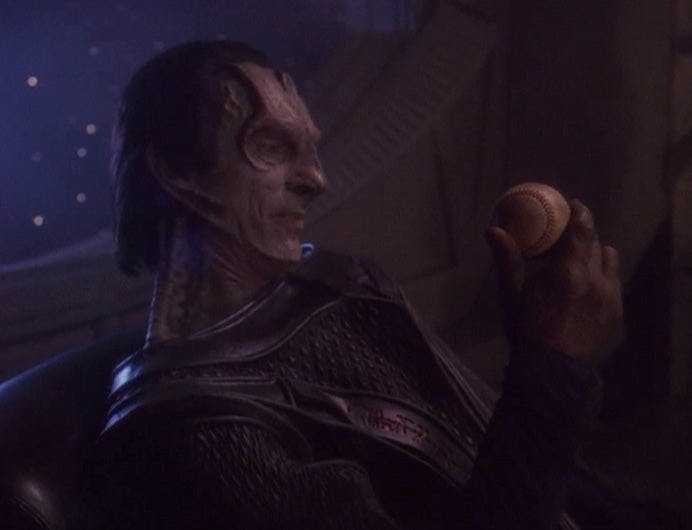
Contrary to a lot of speculation in the 21st Century, “Cardassian” was not a reference to the Kardashians. The Cardassian species first appeared in Star Trek: The Next Generation in 1991, four years before Robert Kardashian served on O.J. Simpson’s defense team, and 16 years before Keeping Up With the Kardashians debuted.
So what was the origin of the name? Star Trek: The Next Generation writer Jeri Taylor realized her original name for the species, “Circassian,” was a real ethnic group (from the Caucasus region of Asia, near Turkey). So she tweaked the name by playing with the sounds. Interestingly enough, the surname “Kardashian” is Turkish or Armenian in origin.
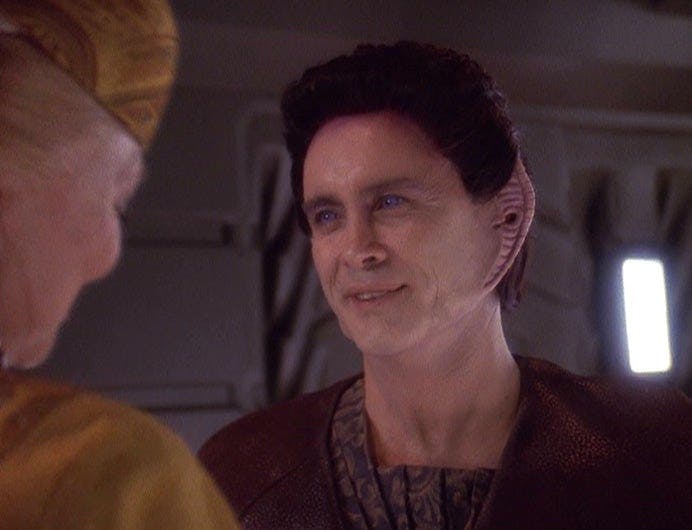
This is an SAT vocabulary word, defined as the territory of a sovereign. Notably, the British Empire referred to its self-governing territories as dominions (and the jemadar being the muscle of the dominion suddenly made a lot more sense). In Star Trek: Deep Space Nin e, the Dominion was the rare galactic power not named after a particular alien race. The Dominion was intended to be an anti-Federation, a distorted reflection of the Federation made up of numerous species. So it was fitting that, just as the Federation had a common name, so did the Dominion.

StarTrek.com has previously discussed the Ferengi name , with farangi being the Persian word for “foreigner.” I found this curious, as firangi is also a Hindi word ascribed to Western foreigners. As it turns out, the Hindi word has its roots in the Persian word, which has its roots in the Middle East’s exposure to Frankish traders during the Middle Ages. The Franks became the farangi, who became the firangi. In the 1980s, Gene Roddenberry used the name for Star Trek: The Next Generation ’s newest villains.
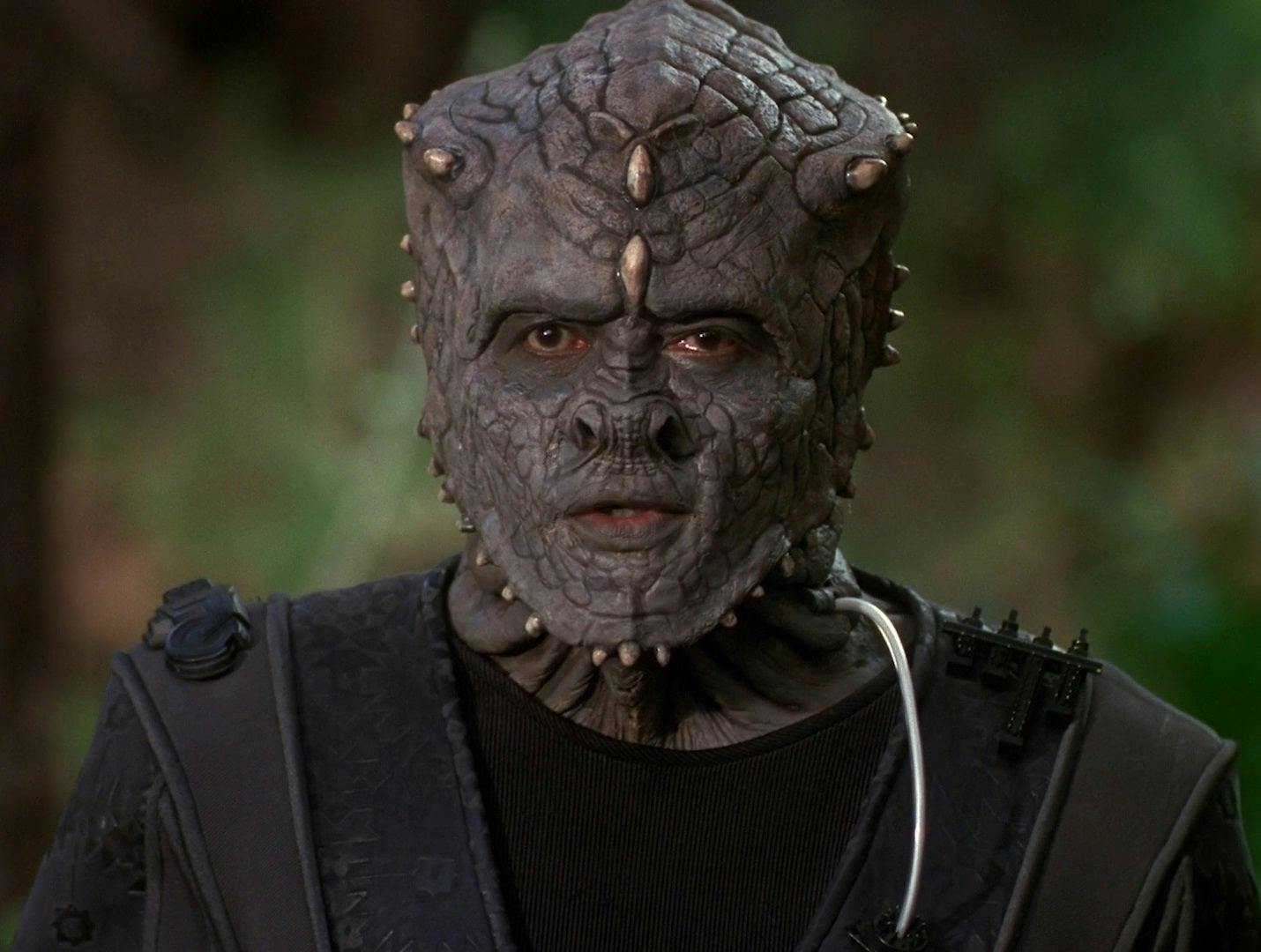
As previously mentioned, jemadar was a rank for junior commissioned officers during the British Raj. The word is Urdu in origin, used in other contexts to describe leaders or officials. In Star Trek: Deep Space Nine , the Jem’Hadar were one species of the Dominion, bred as foot soldiers. However, the name was not meant to draw a direct comparison to jemadars. Writer Robert Hewitt Wolfe recalled developing the species, and simply looking up “soldier” in the thesaurus.

Fitting with American social anxieties of the 1990s, the Kazon’s infighting factions were intended to draw allusions to street gangs. Their original name, however, was slightly different: Gazon. The producers of Star Trek: Voyager changed the name to avoid drawing a comparison to another news topic of the time: the Gaza Strip in the Middle East.
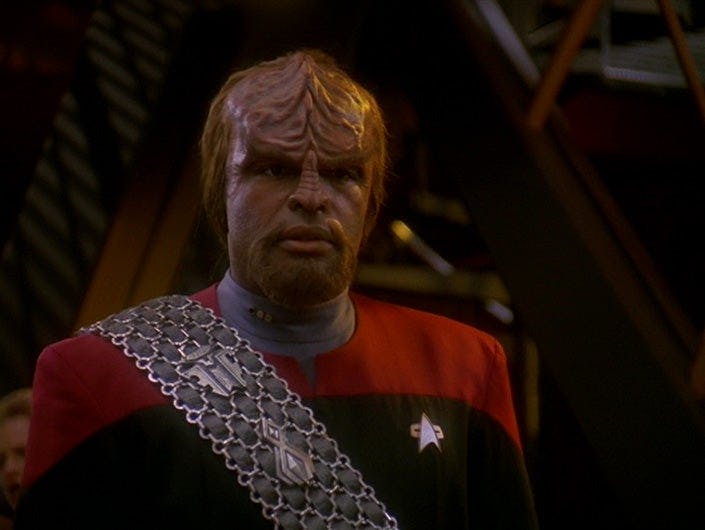
The Klingon language is one of the most famous fictional languages, and volumes have been written about the Klingons as an allegory for the Soviet Union. Less well known is the real-world story behind the name.The Klingon species was named after Wilbur Lee Clingan, Gene Roddenberry’s former colleague in the Los Angeles Police Department. Star Trek was not Clingan’s only brush with show business: He also served as a consultant for the 1960s police procedural show Dragnet . In early Star Trek episodes, some characters pronounced the name closer to “kling-in” than “kling-on,” in line with its origin.

When Gene Roddenberry needed to extend Star Trek: The Next Generation ’s pilot episode to two hours, he devised Q, the omnipotent trickster from a race also known as the Q. Similar to naming the Klingons after someone he knew, he named Q after Janet Quarton, former president of the UK-based fan club Star Trek Action Group.
Romulan and Reman

In Roman mythology, Romulus and Remus were twin brothers who founded the city of Rome. In Star Trek , the characterization of the Romulans and Remans nearly broke the fourth wall, with references to centurions, proconsuls, praetors, and a senate. Quite literally, the “Romulan Star Empire” was just a syllable away from the “Roman Star Empire.” Until I realized this, I never fully appreciated that Captain Kirk was fighting Romans in Space!
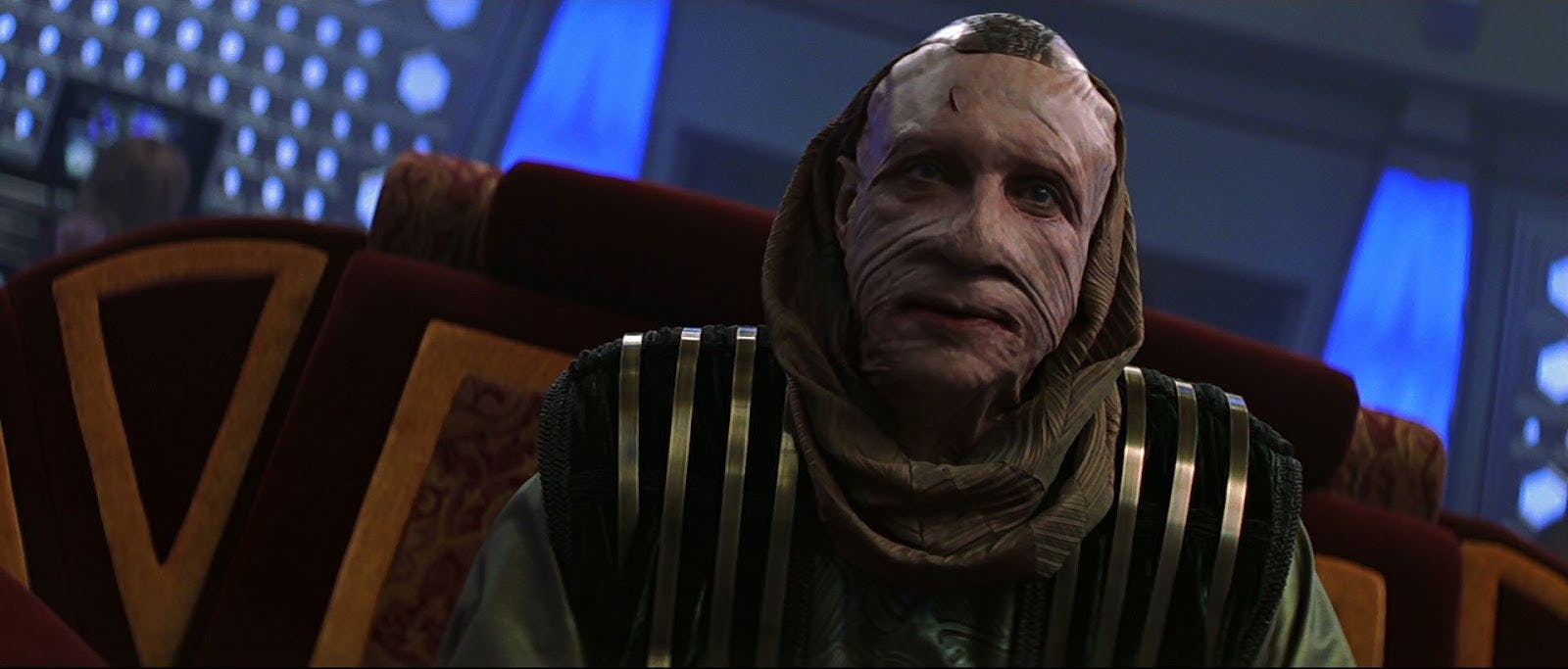
This one I caught immediately as a child, as I watched Star Trek: Insurrection in the theater. Sona is a Hindi word meaning “gold.”
The villainous Son’a (who, like the Jem’Hadar, could benefit from a better skin care regimen) had little to do with gold — notwithstanding the warm colors of the film. Some of the most memorable images from Insurrection were the gold-foiled collector ship of the Son’a, and the churning ambers and reds of the Briar Patch.
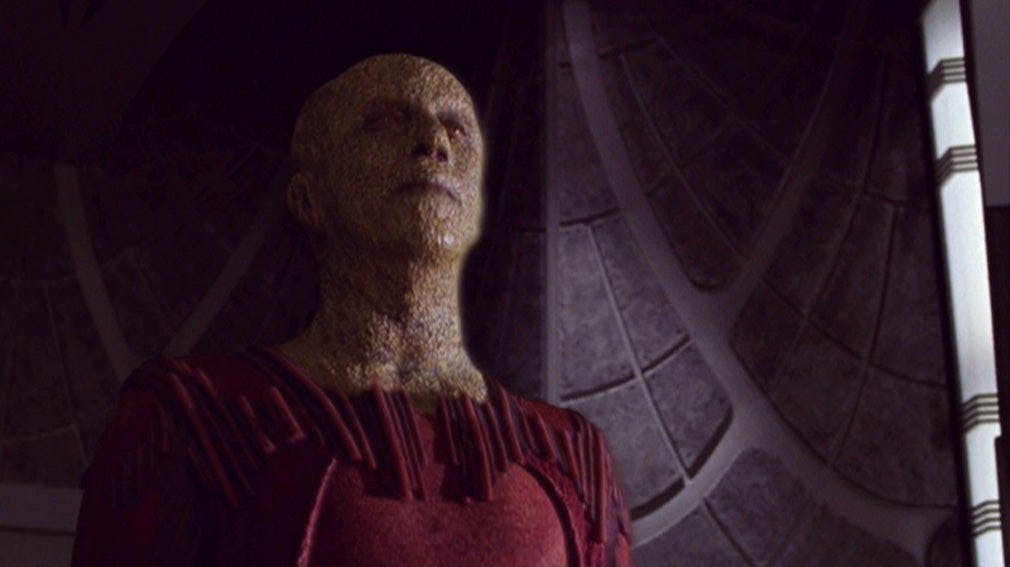
Just as the villains of Star Trek: Voyager reflected the 1990s, the villains of Enterprise reflected the 2000s. When developing the series, producer Rick Berman named the Suliban after the Taliban, drawing on his personal experience as a documentarian in Afghanistan.
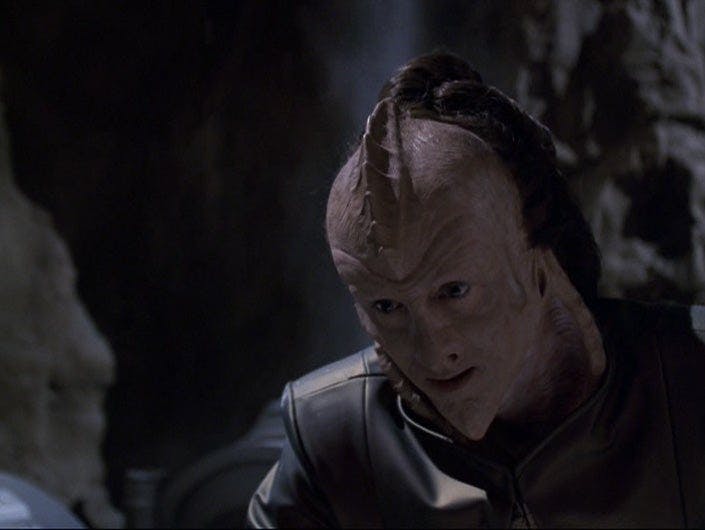
The Vaadwaur looked to be recurring villains in the later seasons of Star Trek: Voyager , but ultimately they caused trouble in just a single episode. Their calling card was the use of subspace tunnels to travel incredible distances, and to appear and to vanish without warning. In Hindi, vah dvaar best translates to “that door.” Had the Vaadwaur become recurring villains, I wondered if their subspace tunnels would have been the door to get Voyager home.
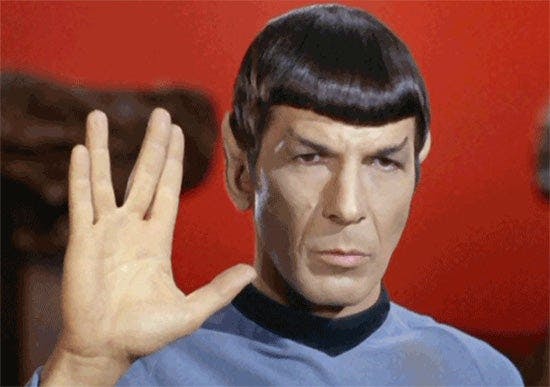
Vulcan is another character from Roman mythology, this time the god of fire. “Vulcan” was also the name given to an apocryphal planet in the 19th century, a hellish world believed to be closer than Mercury to the Sun. Although the name did not align with the cool demeanor of Mr. Spock, it did fit his unbearably hot homeworld.
As I compiled this list for StarTrek.com, I confirmed I was not crazy: There was an Indian influence in Star Trek . What was going on? Western science fiction tended to draw from Western mythology, but Hindi words? The British Raj?
In researching, I learned the doomed Narendra III outpost was named after Naren Shankar, an Indian-American writer who worked on multiple Star Trek series. Meanwhile, Gene Roddenberry’s naming of the Ferengi carried weight in cultures spanning the breadth of Asia. The Jem’Hadar’s name came from the thesaurus.
Star Trek , as I have learned over and over, is not a singular vision. It is a sandbox, in which generations of creative minds have left behind themes, coincidences, and happy accidents. As viewers jump into the sandbox, there is no wrong way to play.
Nitesh Srivastava (he/him) is a writer and marketer who lives in Des Plaines, Illinois. You can find him on Twitter at @niteshsrivastav
Get Updates By Email
Star Trek: 10 Things You Didn't Know About Q
9. he was named after a uk fan club president.

Since Q is an especially unusual name, it makes sense that it has a suitably unusual origin. Though it appears a random choice - because, well, it looks sort of like it's just a random letter - it actually comes from a surprisingly sweet place.
When the show's producer - Gene Roddenberry - came to naming this powerful, fascinating figure, he had one solid idea of who he should be named after; Janet Quarton, his friend and the second president of the Star Trek Action Group.
As someone who is clearly a huge fan of the series, there are likely few better gifts than having a character literally named after you, especially one that has become as renowned as Q has.
And what better tribute to the fans who supported the show than literally naming a character after one of them? While it only gives Quarton explicit bragging rights, it's hard to not hear this story without getting some warm feelings about the love the showrunners clearly had for their fanbase - and no doubt still do, even all these many years later.
I like my comics like I like my coffee - in huge, unquestionably unhealthy doses.
We will keep fighting for all libraries - stand with us!
Internet Archive Audio

- This Just In
- Grateful Dead
- Old Time Radio
- 78 RPMs and Cylinder Recordings
- Audio Books & Poetry
- Computers, Technology and Science
- Music, Arts & Culture
- News & Public Affairs
- Spirituality & Religion
- Radio News Archive

- Flickr Commons
- Occupy Wall Street Flickr
- NASA Images
- Solar System Collection
- Ames Research Center

- All Software
- Old School Emulation
- MS-DOS Games
- Historical Software
- Classic PC Games
- Software Library
- Kodi Archive and Support File
- Vintage Software
- CD-ROM Software
- CD-ROM Software Library
- Software Sites
- Tucows Software Library
- Shareware CD-ROMs
- Software Capsules Compilation
- CD-ROM Images
- ZX Spectrum
- DOOM Level CD

- Smithsonian Libraries
- FEDLINK (US)
- Lincoln Collection
- American Libraries
- Canadian Libraries
- Universal Library
- Project Gutenberg
- Children's Library
- Biodiversity Heritage Library
- Books by Language
- Additional Collections

- Prelinger Archives
- Democracy Now!
- Occupy Wall Street
- TV NSA Clip Library
- Animation & Cartoons
- Arts & Music
- Computers & Technology
- Cultural & Academic Films
- Ephemeral Films
- Sports Videos
- Videogame Videos
- Youth Media
Search the history of over 866 billion web pages on the Internet.
Mobile Apps
- Wayback Machine (iOS)
- Wayback Machine (Android)
Browser Extensions
Archive-it subscription.
- Explore the Collections
- Build Collections
Save Page Now
Capture a web page as it appears now for use as a trusted citation in the future.
Please enter a valid web address
- Donate Donate icon An illustration of a heart shape
Full Circle ( Star Trek)
Bookreader item preview, share or embed this item, flag this item for.
- Graphic Violence
- Explicit Sexual Content
- Hate Speech
- Misinformation/Disinformation
- Marketing/Phishing/Advertising
- Misleading/Inaccurate/Missing Metadata

plus-circle Add Review comment Reviews
5 Favorites
DOWNLOAD OPTIONS
For users with print-disabilities
IN COLLECTIONS
Uploaded by Fanfiction Fanzine Collection Archivist on September 22, 2019
SIMILAR ITEMS (based on metadata)
Q (Star Trek)
Q is an alien recurring character in Star Trek: The Next Generation , Deep Space Nine and Voyager , played by John de Lancie.
The character was named after a fan, Janet Quarton . [1]
You are arrogant, you're overbearing, and you think you know everything. But I do know everything. That makes it worse. -- Vash & Q, 'Q-Less' (DS9)
Q is a representative of a godlike race, also called the Q, and plays a trickster archetype. Despite being a close-to omnipotent being, he almost always presents in the same middle-aged male body and comes across as less mature than Wesley . He has a thing for captains, flirting with Jean-Luc Picard and stealing his girlfriend , and coming on to Kathryn Janeway . He also has an unexplained history with Guinan , which leaves them deadly enemies.
Key episodes include the one where he's made human as a punishment and takes shelter on the Enterprise ('Deja Q', aka the episode that launched a thousand AUs ); the one where he throws the Enterprise at the Borg after Picard turns him down; and the one where he has to make a baby with Janeway to stop a civil war.
Other canonical Q entities, all confusingly also known as Q, include:
- Amanda Rogers, a Q entity raised as human ('True Q', TNG)
- Q2 ('Deja Q', TNG)
- Quinn, a suicidal Q ('Death Wish', Voyager )
- the female Q (Suzie Q, Lady Q), Q's mate ('The Q and the Grey', Voyager )
- Q Junior, Q & the female Q's son ('Q2', Voyager )
Fannish Reception
Q is perhaps the most popular recurring Trek character, with his own newsgroup , alt.fan.q . His popularity went beyond Trek fandom -- he even gets a name check on Buffy the Vampire Slayer !
Alara Rogers on her changing perspectives on the character:
Immediately I decided that I hated the character of Q. He was a ripoff of two or three different Classic Trek concepts -- I counted Trelane, the Metrons, and maybe the Melkotians as well-- and the concepts hadn't been that great the first time. Godlike being puts humanity on trial for being too warlike. Oh, spare me. Q was pompous, arrogant, hypocritical, and apparently none too bright, and I was deeply annoyed with the show for trying to tell me that highly advanced beings would behave like that. ...
...So I watched the Q episode [of DS9] , and discovered something shocking.
He was still arrogant, but now it was clear that he was supposed to be an asshole, that he wasn't emotionally a superior being at all, and that that was the point. Q is the guy, in D&D terms, with the Intelligence of 18+ and the Wisdom of 3. He's an arrogant, overbearing, obnoxious jerk who, unfortunately, really does know everything. The character was far, far funnier than I remembered. ...
Rather than being the mere plot device (and a ridiculous one at that) he was in the first episode of TNG, I found that Q was actually a character who changes and grows over time throughout his appearances on the series. Unlike every other godlike alien Classic Trek, or even TNG and DS9, presented us with, Q is just this guy. He's not merely a foil for the good guys to prove how moral, how smart, or how agnostic they are; he's a character, a person in his own right. And while his species is obviously very different from ours, it's clear that emotionally, they're pretty damn similar. Which isn't all that likely, but what the hell, it's TV, I can suspend my disbelief. [2]
Atara Stein on an early Q episode, 'Hide and Q':
...Q needed a new twist. Fortunately for his subsequent appearances on the show, de Lancie establishes some interesting facets of Q's demeanor that will provide significant material later. One is simply the energy of his performance, particularly given the stilted lines he is given. ... He is such fun to watch, particularly in Q's confrontations with Picard, that he had to be brought back in some fashion. This episode also subtly (or not so subtly) establishes Q's polymorphous sexuality. His demeanor toward Riker during their conversation on the planet is campy and seductive; he draws close to the first officer, invading his personal space and giving him a series of low-lidded seductive looks while speaking in a bedroom voice that incongruously undermines the pretentious dialog about human evolution. One viewer, who had never seen a Q episode before, watched a minute or so of this scene, then asked, "Is Q gay?" Q's smile and tone of voice with which he delivers the line "You're gonna miss me" is far more flirtatious than menacing. [3]
Alexander V. on the appeal of Q:
The universe isn't like that. There are no 'good' and 'bad' guys. I personally think that's why Q is on the show. On one side you have all those Federation boys who think they know EXACTLY what is right and what is wrong. And the other side you have Q who is a 'bad' guy (But only to Federation standards), but he shows that things like 'good' and 'bad' are just personal concepts. ...
Q shows that our human standards are not the only ones. They might even be wrong. In fact they probably are wrong. [3]
In Fanfiction
A lot of fans could only explain Q's behaviour by assuming he was in love with Picard; Picard/Q gained a devoted following to become one of the major TNG slash pairings. Janeway/Q failed to have the same popularity, with many fans considering the pair had no chemistry. Q also gets paired with many other Trek characters, including Paris , Bashir and Data , not to mention droves of original characters who often score highly on the Mary-Sue scale.
Non-explicit Q fanfiction frequently explores Q's true nature and how it differs from the human experience, often in the context of a trusting relationship with another character. Q is sometimes included in ensemble adventures (occasionally for Trek series in which he doesn't appear), usually as a generic villain or as a plot device for time or dimensional travel, or the like.
Fanfiction starring Q often imitates episode titles by using Q in the title, for example, 'EsQPade' ( Brenda Antrim ) and 'Another Turn of the Q' ( JoAnne Soper-Cook ).
Example Fanworks
- The King Who Would Be Man by M Fae Glasgow (in Pæan to Priapus II ; 1990) -- an early printzine example of the pairing with many of the ideas explored in later fanfiction already in place: female Q, female Picard, d/s powerplay, Q affected by human emotions after his spell of humanity
- Sanity & Reality by Tiggy Malvern (c.2002) -- set during the Dominion War arc of DS9
- Accidental by Shalott (2003) -- Q's true form
- A Far Distant Star by Icarus Chained (2007) -- explores Q's experience of the universe via Deanna Troi
- Love at First Q by Lindsey J. Shelton (n.d.)
- For more examples, see the Picard/Q article

- Only Human by Alara Rogers -- a novel in which Q never regains his powers after 'Deja Q'; Q/f (started in 1993; remains a WiP as of 2012)
- Several spinoff AUs in the Only Human verse are almost as well known, including PropinQuity by Mercutio and InseQurity by Mercutio & Alara; Q/f
- The Night The Day The War Began by Alara Rogers (2009) -- Q/Amanda Rogers (another Q entity). Alien sex
- The Friends With Benefits series by Alara Rogers (2009-2011) -- a group of post- Voyager stories in which Q and Janeway are casual lovers
- Dance of Chameleon and Mirror by Alara Rogers (1994) -- backstory for Q and Guinan
- From Me to Q by Julia Houston (c.1997) -- episode-like adventure with implied P/Q
- Beyond Gloomy Chaos by Laura Taylor (2000) -- post-DS9 novel
- And Justice For Q by John Berger (2001) -- fallout for the Borg incident
- Alara's Q Archive -- small archive of stories selected by Alara Rogers
- Alt.Fan.Q Story Archive -- archive for alt.fan.q , plus recs from Mercutio
- Q Fan Fiction Library (defunct)
- Works tagged 'Q' at Archive of Our Own
- TNG & Voyager works tagged 'Q' at fanfiction.net
Masterlists
- BiblioQ -- directory of Q fanfiction to 1997, both printzine & online, reviewed by Alara Rogers & Mercutio
Personal sites
- Q-niverse: Alara Rogers
- JM's Fanfiction
- Mercutio's Fanfiction (also other fandoms)
- Queriana's Q-FanFiction (defunct)
- Varoneeka's Slash, Mush, and More...
Anthology Fanzines
- Qubed (1992)
- Quisine (?-1991; 4 issues) -- publication of the Q Appreciation Society , with fanfiction and essays
Mailing Lists
- alt.fan.q -- for discussions of Q, other Q, Q from James Bond , actors that play Q, and postings of stories about Q. Basically anything Q. Also lengthy discussions of other characters played by John de Lancie. [4]
Yahoo groups
- PiQuante -- Picard/Q
- 'More Maligned than Malignant' by Annie Hamilton (?-1991) -- series of three essays on Q's role as a teacher, which appeared in the zine, Quisine
- 'Star Trek's Q: A Byronic Hero for The Next Generation' by Atara Stein (1994); paper presented to the Philological Association of the Pacific Coast & reprinted in The Byronic Hero in Film, Fiction, and Television -- discusses Q's resemblance to Byron
- Q Rules! by Atara Stein (1995)
- Minding One's P's and Q's: Homoeroticism in Star Trek: The Next Generation ( link ) by Atara Stein (1998) -- Picard/Q
- Through and Through Q by Alara Rogers (2004)
- Captain Control and the God of Ritalin by Alara Rogers (2004) -- Picard/Q
- ^ This is reported in Gene Roddenberry 's authorized biography, Star Trek Creator by David Alexander.
- ^ Idol Reflections: Through and Through Q (accessed 15 May 2012)
- ^ a b Q Rules! An Unauthorized History (accessed 15 May 2012)
- ^ alt.fan.q: FAQ for Alt.Fan.Q (accessed 17 May 2012)
- Star Trek DS9 Characters
- Star Trek TNG Characters
- Star Trek VOY Characters
Navigation menu

IMAGES
VIDEO
COMMENTS
Janet Quarton is an influential and long-time Star Trek fan. She lives in the UK and has been a participant in the UK Star Trek fan community since the early 1970s. She was was the president of Star Trek Action Group from 1973 and 1981. She wrote: "I joined STAG as soon as I saw it advertised and was always proud of my membership number -- no. 2." Janet, along with Sheila Clark and Valerie ...
Much of this collection is made up of Star Trek fanzines published by UK fanzine publisher ScoTpress, which operated from 1975 to 1996. Quarton was one of several editors and also the founder of the Star Trek Action Group. The newsletter for the group, nearly fifty issues, is collected here in its entirety.
Acceptance (Star Trek fanzine) ScoTpress is a fan-run fanzine publisher based in Scotland. Founded by Janet Quarton, Sheila Clark & Valerie Piacentini, it published 145 zines between 1975 and 1996. The same group also published zines for Star Trek fan clubs: 69 for the Star Trek Action Group or STAG (a Star Trek Original series club) and 19 for ...
Then in 1973 Jenny and Terry Elson formed the Star Trek Con for Britain Action Group with the aim of raising enough money to run a Star Trek Convention in Britain. The first newsletter must have come out in April or May as the second one was June/July. The name of the club was soon shortened to the Star Trek Action Group and became more ...
Q was named by none other than Star Trek creator Gene Roddenberry, who chose the unusual alias in honor of his friend Janet Quarton. A long-time Star Trek fan, Quarton was the president of the ...
Show 4 more comments. The character Q played by actor John de Lancie in the character's debut in the Star Trek:The Next Generation pilot, Encounter at Farpoint was inspired by a long-time British fan of the franchise named Janet Quarton. In the early 1970's Brittain there were only a few fan followings available and all seemed to fall short of ...
28) The name "Q" was chosen by Roddenberry in honor of an English Star Trek fan named Janet Quarton. She was the first president of the UK Star Trek fan club, and Roddenberry and many others spent time at her home, in the Scottish highlands. (Star Trek Encyclopedia (4th ed., vol. 2, p. 191); )
The original character was named after Janet Quarton, the president of the UK's first Star Trek club and someone whom Roddenberry greatly admired. Even though Q was essentially just a spiffier version of The Original Series character Trelane (something writers and fans wasted no time reminding Roddenberry), the character — anchored by John ...
ScoTpress published 145 zines between 1975 and 1996. Founded by Janet Quarton, Sheila Clark & Valerie Piacentini.. The same group also published zines for clubs, 69 for the Star Trek Action Group or STAG (a TOS club) and 19 for IDIC (a TOS/TNG club), for a total of 233 publications. Originally all zine production was through STAG, but then zine production split from it.
Janet Quarton Star Trek Fanzine Collection, MsC0973. University of Iowa Special Collections. Copy to clipboard. Cite Item Description. The Tribe of Jen-Wae, 1981 June, Box: 9. Janet Quarton Star Trek Fanzine Collection, MsC0973. University of Iowa Special Collections.
Star Trek creator Gene Roddenberry named Q after a woman...sort of. Roddenberry chose the singular letter "Q" as a tribute to a woman by the name of Janet Quarton, the first President of the U.K. Star Trek fan club. As history tells it, Roddenberry was good friends with Quarton, who helped push the Star Trek concept to audiences over the pond, and contribute to its success.
Janet Quarton, a Scottish Star Trek zine publisher and preservationist, scanned about 500 zines herself in 2013. But even Zinedom's digital collection is only a fragment of what's out there.
Quarton, Janet Person Staff Only Found in 1 Collection or Record: Janet Quarton Star Trek Fanzine Collection Collection Identifier: MsC0973. Abstract. Star Trek fanzines. Dates: Publication: 1973-2011 Found in: University of Iowa Special Collections. Staff Interface ...
This is a growing archive of Star Trek: TOS stories originally published by STAG, ScoTpress and IDIC between 1975 and 1996. Stories mostly involve character interaction in an action-adventure format. It also includes a few stories which are either unpublished or were originally printed in other zines ... ScoTpress - Janet Quarton, Sheila Clark ...
When Gene Roddenberry needed to extend Star Trek: The Next Generation's pilot episode to two hours, he devised Q, the omnipotent trickster from a race also known as the Q. Similar to naming the Klingons after someone he knew, he named Q after Janet Quarton, former president of the UK-based fan club Star Trek Action Group.
Star Trek uses the name "Q" for the names of all the individuals from the Q species. All male and female Q characters refer to each other as "Q." ... Gene Roddenberry chose the letter "Q" in honor of his friend Janet Quarton. References This page was last changed on 12 October 2021, at 13:49. ...
The Star Trek Action Group, commonly called "STAG," was a fan club founded by Jenny Elson & Terry Elson in 1973 with the aim of raising enough money to run a Star Trek Convention in Britain. ... Janet Quarton (of IDIC fame) took over the running of the club. Previously in 1974, Janet joined as Membership Secretary. She would remain as President ...
IDIC Log 04. ScoTpress is a fan-run fanzine publisher based in Scotland. Founded by Janet Quarton, Sheila Clark & Valerie Piacentini, it published 145 zines between 1975 and 1996. The same group also published zines for Star Trek fan clubs: 69 for the Star Trek Action Group or STAG (a Star Trek Original series club) and 19 for IDIC (a Original ...
Star Trek: 10 Things You Didn't Know About Q. 9. He Was Named After A UK Fan Club President ... Janet Quarton, his friend and the second president of the Star Trek Action Group. ...
Full Circle ( Star Trek) ScoTpress is a fan-run fanzine publisher based in Scotland. Founded by Janet Quarton, Sheila Clark & Valerie Piacentini, it published 145 zines between 1975 and 1996. The same group also published zines for Star Trek fan clubs: 69 for the Star Trek Action Group or STAG (a Star Trek Original series club) and 19 for IDIC ...
Q is a fictional character, as well as the name of a race, in Star Trek, appearing in the Next Generation, Deep Space Nine, Voyager, Lower Decks, and Picard series and in related media. The most familiar Q is portrayed by John de Lancie.He is an extra-dimensional being of unknown origin who possesses immeasurable power over time, space, the laws of physics, and reality itself, being capable of ...
"With regard to the recent letters about how T'hy'la is pronounced, I think I can provide the definitive answer. Just after the novelization of ST:TMP appeared, Gene Roddenberry was on holiday in Scotland, visiting Janet Quarton, who for many years ran Star Trek clubs in Britain. There had been quite a bit of discussion in K/S circles about ...
The first model of the USS Enterprise is displayed at Heritage Auctions in Los Angeles, April 13, 2024. The model — used in the original "Star Trek" television series — has been returned ...
Q is an alien recurring character in Star Trek: The Next Generation, Deep Space Nine and Voyager, played by John de Lancie. The character was named after a fan, Janet Quarton. In Canon. You are arrogant, you're overbearing, and you think you know everything. But I do know everything. That makes it worse.--Vash & Q, 'Q-Less' (DS9)